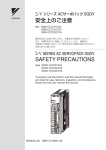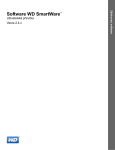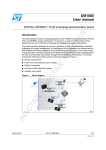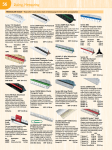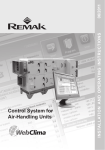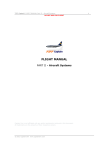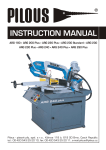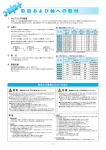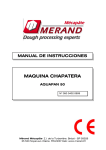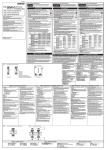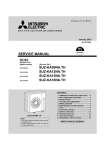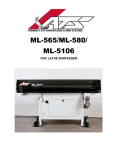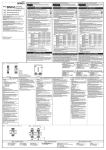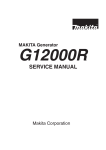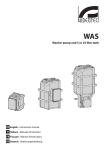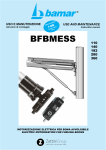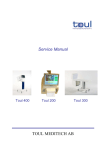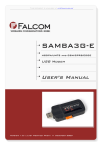Download identification of instructions
Transcript
CNC Technology, spol. s.r.o. SPACESAVER 2220 CNC LATHE BARFEEDER v027-95001 INSTALLATION, OPERATION AND MAINTENANCE MANUAL REKLAMA A27_SS2220_V1.2 Safety Instructions Before starting the work with the barfeeder pay attention to the following instructions: With regard to continuous improving of barfeeders it is possible that the illustrations and descriptions provided in this manual can differ in details from the delivered equipment. When working with electric circuits follow the regularly updated diagrams in this manual. If you find diagrams attached to this manual, please use them, because they contain changes which have not yet been addressed in the printed copy of the manual sent to you. The barfeeder enables the simplest and safest feeding of bars into the spindles of standard CNC lathes. Some common workshop practices do not meet the labour safety principles and should be checked or revised according to the following recommendations. The barfeeder operator should observe the labour safety principles. Furthermore the operator should ensure that the machine is installed by a specialist, and should carry out regular inspection of the barfeeder functions and condition. Before starting the work with the barfeeder read carefully the following instructions: Before barfeeder operation or maintenance, read carefully both this Manual and the attached supplementary information. Make sure that you have understood everything well. Make sure that the barfeeder is properly set, aligned with the lathe and fastened to the ground. Do not work with the equipment which has not been properly installed, checked and prepared for operation and is not regularly maintained. Do not remove any safety plates and labels with signs or warnings, and follow the instructions shown on them. Do not slacken screw joints which are secured by paint. Do not work with the equipment which produces excessive noise, heat or vibration. In your own interest call immediately attention of the personnel responsible for the barfeeder operation and maintenance to the problem. Make sure that the machine is properly grounded in accordance with valid standards. Disconnect the machine from electric power supply before any repair or maintenance. Do not touch electric control or power parts until they are disconnected from electric power supply. Do not touch electric equipment by wet hands or while you are standing in a moist environment. Electric equipment of the barfeeder can only be repaired by an authorized person. Replace the fuses only by the fuses of the same rating and type as those which have been installed by the manufacturer. Keep the space around the machine dry, clean and properly lighted. Have suitable extinguishers ready at work with flammable substances. Remove turnings and all other waste, especially flammable one, from the barfeeder regularly. Do use flammable or toxic substances instead of cleaning agents. Do not change the connection or function of safety switches, indicators and fuses, and do not short-circuit or otherwise by-pass this equipment. Before the use the barfeeder remove all parts and tools from the barfeeder and its vicinity, in particular from the vicinity of its moving parts. If the machine has been out of service for a longer time, check the machining program, part clamping and setting of the barfeeder parameters before fully automatic operation of the lathe with the barfeeder. SS2220 3 Safety Instructions Do not remove or unlock safety guards during barfeeder operation. Do not remove or add bars while the barfeeder is running. Do not wear rings, bracelets, watches, too free clothing etc at work with the barfeeder. Long hair should be protected by a suitable cap. Do try to stop or slow down the barfeeder by your own hands. Accessories, which were not delivered by the manufacturer within the basic shipment, must be checked thoroughly by authorized personnel in installation. Be especially careful close to unprotected moving parts, in particular in their initial setting. Beware of sharp edges of parts. Use only hammers with a soft head (if you must use the hammer). Observe operating limits of the equipment given in the specification. Use spindle insert to ensure correct position of the bar in the lather spindle. Do not process the bars exceeding the length of the lathe spindle/spindle insert. Make sure that the channel is empty before loading a bar from the table into the channel. Always set the parameter #101 with a sufficient margin to eliminate contact of the pusher with the rotating spindle Set a minimum value of the parameter #300. Too high feeding force overloads both the barfeeder and the lathe. Before start of the work make sure that all safety circuits are active. Check where all Stop and Total Stop pushbuttons are located. Prior to activation of the automatic cycle make sure that all required functions are properly set and that all controls are set to correct position. Observe labour safety principles!!! 4 SS2220 Table of Contents TABLE OF CONTENTS List of Figures.......................................................................................................................................7 IDENTIFICATION OF INSTRUCTIONS............................................................................................ 8 Conditions of guarantee.................................................................................................................... 9 1 Description.......................................................................................................................................10 1.1 General description............................................................................................................10 1.2 Application............................................................................................................................10 1.3 Concept................................................................................................................................. 11 1.4 Technical specification..................................................................................................... 11 1.5 Process description........................................................................................................... 16 1.6 Installation............................................................................................................................ 16 1.7 Identification and serial number.....................................................................................17 2 Transport and unpacking.............................................................................................................18 3 Installation........................................................................................................................................20 3.1 Preparation before installation........................................................................................20 3.2 Barfeeder alignment...........................................................................................................21 3.2.1 General........................................................................................................................21 3.2.2 Presetting the height and side position.................................................................. 21 3.3 Electrical connection......................................................................................................... 25 4 Operation..........................................................................................................................................26 4.1 Primary prerequisites........................................................................................................ 26 4.1.1 Putting into operation, anchoring, alignment.........................................................26 4.1.2 Safety of operation.................................................................................................... 26 4.1.3 Attendance..................................................................................................................26 4.2 Working procedures.......................................................................................................... 26 4.3 Bar guiding........................................................................................................................... 27 4.4 Bar feeding........................................................................................................................... 28 4.5 Installation or replacement of spindle insert (at change of the bar diameter)...28 4.6 Setting the loading channel position (at change of the bar diameter)................28 4.7 Setting the magazine position (at change of the bar diameter)............................. 29 4.8 Pusher....................................................................................................................................30 4.9 Barfeeder control................................................................................................................ 31 4.9.1 Mechanical controls...................................................................................................31 4.9.1.1 Mode Switch (S3)........................................................................................... 31 4.9.2 Software controls....................................................................................................... 32 4.9.2.1 Basic Screens of the Program......................................................................33 4.9.2.2 Overview of Soft Keys and Lamps.............................................................. 35 4.9.2.3 Power OFF Screen........................................................................................ 37 4.9.2.3.1 User Levels and Their Meaning........................................................37 4.9.2.4 Manual Mode.................................................................................................. 39 4.9.2.4.1 Move to Zero Position........................................................................ 39 4.9.2.4.2 Barfeeder Motions...............................................................................39 4.9.2.5 Auto Mode....................................................................................................... 40 4.9.2.5.1 Automatic Cycle Start.........................................................................40 4.9.2.5.2 Automatic Cycle Termination............................................................ 40 4.9.2.5.3 Refilling Bars in the Magazine.......................................................... 40 4.9.2.5.4 Lathe Operation Without Barfeeder................................................. 40 4.9.2.6 Statistics...........................................................................................................41 4.9.2.6.1 Counters............................................................................................... 41 4.9.2.7 Settings............................................................................................................ 41 4.9.2.7.1 Real time.............................................................................................. 41 SS2220 5 Table of Contents 4.9.2.8 Alarm History...................................................................................................42 4.10 Barfeeder parameters......................................................................................................43 4.10.1 Parameters............................................................................................................... 43 4.10.1.1 Parameter Selection.................................................................................... 43 4.10.1.2 Parameter Types and Their Setting.......................................................... 44 4.10.1.2.1 Parameters of List Type...................................................................44 4.10.1.2.2 Parameters of Position Type...........................................................44 4.10.1.2.3 Parameters of Other Type...............................................................44 4.10.2 Operator parameters...............................................................................................45 4.10.2.1 Setting of the Loading Mechanism............................................................ 46 4.10.2.1.1 #111 – Bar Dimension......................................................................47 4.10.2.1.2 #013 – Bar Profile............................................................................. 47 4.10.2.2 #006 – Language......................................................................................... 47 4.10.2.3 #010 – Push Mode.......................................................................................48 4.10.2.4 #100 – End of Bar........................................................................................ 49 4.10.2.5 #101 – Pusher Retract Position................................................................. 50 4.10.2.6 #102 – Collect Face Position......................................................................50 4.10.2.7 #105, #106 – First and Second Feeding Length.....................................51 4.10.2.8 #107 – New Bar Face Position.................................................................. 51 4.10.2.9 #113 – Second EOB.................................................................................... 51 4.10.2.10 #300 – Feeding Force............................................................................... 52 4.10.2.11 #301 – Retract Delay.................................................................................52 4.10.3 Service parameters................................................................................................. 53 4.10.3.1 #000 –Automatic Mode............................................................................... 53 4.10.3.1.1 Automatic........................................................................................... 54 4.10.3.1.2 Simulation.......................................................................................... 54 4.10.3.1.3 Test..................................................................................................... 56 4.10.3.1.4 Calibration.......................................................................................... 57 4.10.3.2 #001 – Feeding on M-code.........................................................................57 4.10.3.3 #002 – End of Bar Timing........................................................................... 58 4.10.3.4 #004 – Stat/Dyn Mcode...............................................................................58 4.10.3.5 #005 – Invert Chuck Open Signal..............................................................58 4.10.3.6 #007 –K4 Relay............................................................................................ 59 4.10.3.7 #009 – Factory Reset.................................................................................. 59 4.10.3.8 #103 – Barfeeder Stroke.............................................................................60 4.10.3.9 #104 – Global Channel Offset....................................................................60 4.10.3.10 #108 – Material Switch Position.............................................................. 61 4.11 How to program a lathe with the barfeeder............................................................... 62 4.11.1 Feeding to stopper.................................................................................................. 62 4.11.2 Feeding to position.................................................................................................. 63 4.11.3 Parameter setting example.................................................................................... 64 5 Maintenance.................................................................................................................................... 66 5.1 Routine maintenance.........................................................................................................66 5.2 Error messages................................................................................................................... 67 5.3 Electrical equipment.......................................................................................................... 72 5.3.1 arrangement and meaning of switches.................................................................. 72 5.3.2 PLC A (CP1E)............................................................................................................ 73 5.3.2.1 CP1E LED status............................................................................................73 5.3.3 Battery......................................................................................................................... 74 5.3.4 Interface description.................................................................................................. 75 5.3.5 Diagnostics................................................................................................................. 77 5.3.6 Wiring diagrams......................................................................................................... 77 6 Installation report...........................................................................................................................78 6 SS2220 Table of Contents LIST OF FIGURES Fig. 1.1 Fig. 1.2 Fig. 1.3 Fig. 2.1 Fig. 3.1 Fig. 3.2 Fig. 3.3 Fig. 3.4 Fig. 4.1 Fig. 4.2 Fig. 4.3 Fig. 4.4 Fig. 4.5 Fig. 4.6 Fig. 4.7 Fig. 4.8 Fig. 5.1 Fig. 5.2 Fig. 5.3 SS2220 - Main Dimensions of the Barfeeder – Axial Retraction Mechanism...................................... 14 - Main Dimensions of the Barfeeder – Radial Retraction Mechanism.................................... 15 - Nameplate.............................................................................................................................. 17 - Barfeeder Lifting and Seating................................................................................................19 - Setting the Height and Side Position..................................................................................... 21 - Setting Kit...............................................................................................................................22 - Barfeeder Anchoring..............................................................................................................24 - Electrical Connection............................................................................................................ 25 - Bar Guiding in the Spindle Insert.......................................................................................... 27 - Bar Feeding........................................................................................................................... 28 - Magazine Position Setting..................................................................................................... 29 - Pusher Dismantling and Mounting........................................................................................ 30 - Control Panel.........................................................................................................................31 - Linear Operator Parameters................................................................................................. 45 - Setting of parameter #100 - End Of Bar................................................................................49 - Example of cut off the bar face.............................................................................................. 64 - Routine Maintenance............................................................................................................. 66 - Arrangement of Electrical Elements......................................................................................72 - PLC A.....................................................................................................................................73 7 Identification of Instructions IDENTIFICATION OF INSTRUCTIONS Important instructions are emphasized in this manual as follows: Failure to observe these instructions can result in injury of the operator. Failure to observe these instructions can result in damage to the barfeeder or the lathe. Other important instructions 8 Parameter numbers are identified as #xxx in this manual, where xxx is the parameter number. SS2220 Identification of Instructions CONDITIONS OF GUARANTEE If not stated otherwise in the contract concluded between the buyer and the manufacturer, the barfeeder manufacturer provides the guarantee for the Spacesaver SS2210 according to the following table. Guarantee period Conditions of guarantee 1 year from dispatch Provided the customer himself installs the barfeeder. 2 years from installation (max. 2.5 years from dispatch) Provided the barfeeder is installed by the manufacturer or by other person authorized by the manufacturer. Furthermore, immediately after installation such person must fill in the record of installation of the barfeeder, see the last page of this manual, and send it to the manufacturer. Otherwise the guarantee is valid for 1 year from dispatch. The guarantee does not cover the parts that are subject to ordinary wear and tear such as plastic guide bushing of the pusher etc., and the failures caused by not performing regular maintenance see Chapter 5.1. Furthermore, the guarantee does not cover the bending or other mechanical damage to the pusher caused by excessive feeding force, pusher clamping in the collet, pusher jamming between the spindle insert or by other eventual operator's error. Guarantee repair or barfeeder installation does not cover additional training of the operator and resetting the barfeeder or other activities which have already been carried out within proper installation and which have been documented in the installation record. The manufacturer reserves the right to deem these additional acts ordinary service action. SS2220 9 Chapter 1 – Description 1 DESCRIPTION 1.1 GENERAL DESCRIPTION The barfeeder SS2220 has been designed for work with any type of CNC lathe equipped with a suitable interface. The length of the bars is limited by the length of the lathe spindle (with a clamping cylinder and clamping device). As the barfeeder does not touch any rotating part of the lathe or rotating bar, it is possible to utilize full range of operating speed of the lathe. Barfeeder design enables automatic loading and feeding of bars into the lathe with minimum built-up area required. Barfeeder setting up and programming is easy and fast. Bars must be guided by the spindle insert in the lathe. The remnant of the bar, from which it is not possible to make a part, is forced by the barfeeder into the lathe workspace, with no additional equipment needed. The barfeeder is designed for work with round, hexagonal and square bars. For feeding of non-circular cross section bars the lathe must be equipped with a spindle orientation. 1.2 APPLICATION Barfeeders of SS2220 series provide: Functions Cheap and effective automation of operation of any CNC lathe Workspace saving thanks to side storage and loading of bars Automatic loading of a new bar after processing of the previous bar Precise work at high speed of the lathe spindle unaffected by the barfeeder Processing of bars of imperfect shape or dimensions Bar feed against the lathe stopper Bar feed to a programmed position (without stopper) - option NOTICE Barfeeders SS2220 are not suitable for twin-spindle lathes, which uses the second spindle for material feeding. For such technology it is recommended to use e.g. barfeeder SS2500 or any other model suitable for twin-spindle lathes. For detailed information contact the barfeeder seller or manufacturer. 10 SS2220 Chapter 1 – Description 1.3 CONCEPT The barfeeder SS2220 is a powerful machine with a long service life and minimal maintenance required. Its simple operation and functions facilitate work even to less skilled workers. The barfeeder is controlled by means of the control panel in the right part of the machine. There is an E-Stop pushbutton for emergency stop on the control panel. In the left part of the barfeeder frame there is a Q1 switch. Bars are loaded in the magazine. Loading of bars into the lathe is ensured by a loading channel, splitter and a flag with a pusher. On the rear side of the frame there are connectors X1, X2 for barfeeder interconnection with the lathe. It is also possible to install there a magazine for spindle inserts. 1.4 TECHNICAL SPECIFICATION Application For all CNC lathes equipped with a suitable interface Scope of application Bar of round cross section Bar of hexagonal cross section Bar of square cross section Bar dimension 6 to 67 mm 8 to 58 mm 8 to 47 mm Bar weight Maximum weight of the loaded bar 45 kg Bar length Minimum length of the bar handled by the barfeeder Maximum length of the bar handled by the barfeeder 200 mm 1525 mm NOTICE Actual max. length of the bar is limited by the length of the spindle (with clamping cylinder and clamping device). Magazine capacity depending on the bar diameter 6 bars The number of bars limited by the table capacity 67 mm 6 mm Total weight of all bars on the table must not exceed 250 kg. SS2220 11 Chapter 1 – Description Pusher stroke Design stroke Working stroke Maximum distance of the clamping device face from the pusher point in back position 1665 mm 1660 mm 1655 mm Technology of bar handling The bar is centred in the lathe spindle by spindle inserts, and shifted by the pusher to a stopper in the tool head. Spindle speed Depending on lathe design and quality of spindle insert. Bar preparation No specific requirements for bar preparation. Bar straightness Bar must freely go into the user selected spindle insert. Bar loading cycle approx. 20 to 30 s Setting time at change of bar diameter Max. 1 minute at change to other diameter + time of lathe spindle insert replacement Color design Light Grey Weight approx. 360 kg Packaging Transport dimensions length 2230 x width 1150 height 1230 mm length 2230 x width 1150 height 1395 mm (long legs) Barfeeders are sealed in plastic sheet and transported on non-returnable pallets or in boxes. Pallet weight is approx. 35 kg, the weight of the whole box approx. 170 kg. 12 SS2220 Chapter 1 – Description Electrical equipment Power supply Power circuits Logic circuits 200/230/400 VAC, 50/60 Hz, 400 VA 200 VAC, 24 VDC 24 VDC, 5 VDC Batteries Durability PLC approx. 5 years at 25°C (1) Data backup time at switching off max. 50 days Recharging time to 100% capacity 96 hours (1) The values apply to batteries charged to 100% capacity. Noise emission HMI approx. 5 years at 25°C max. 100 days 96 hours The values have been stated in accordance with ČSN EN ISO 4871 and basic standard ČSN EN ISO 11201. A Measured emission level of sound pressure A, PpAd at the operator workplace (dB) Uncertainty, KpA (dB) SS2220 B w/o bars with bars w/o bars 67 69 68 with bars 71 4 4 4 4 13 Chapter 1 – Description Main dimensions of the barfeeder– axial retraction mechanism Fig. 1.1 - Main Dimensions of the Barfeeder – Axial Retraction Mechanism 14 SS2220 Chapter 1 – Description Main dimensions of the barfeeder– radial retraction mechanism Fig. 1.2 - Main Dimensions of the Barfeeder – Radial Retraction Mechanism SS2220 15 Chapter 1 – Description 1.5 PROCESS DESCRIPTION SS2220 barfeeder feeds bars into the lathe as follows: The channel takes a bar from the magazine, lifts it to the lathe spindle axis level, and waits in the position to the remnant ejection command. The lathe opens the clamping device, and sends the first M-code (for bar remnant ejection). The flag shifts the bar into the spindle and after it returns to back limit position. The channel moves to the lower limit position and the pusher is tilted to the spindle axis. The barfeeder pushes the bar by the pusher through the open clamping device 1mm in front of the clamping device (ejects the remnant), and terminates the first M-code. The lathe sends the second M-code. Barfeeder pushes the bar by the pusher against the stopper in the tool head or to a required position in front of the clamping device, and terminates the second M-code. The clamping device closes, and the pusher returns. The lathe machines the piece. Next bar feed is executed, when the spindle stops, clamping device opens, and M-code is sent. If the bar length is insufficient to make another part, the barfeeder sends the End of Bar signal. The signal is tested by the lathe program which issues a command to eject the remnant of the bar and load a new bar. 1.6 INSTALLATION It is recommended to carry out installation by the manufacturer's technicians or by persons authorized by the manufacturer. Prior to installation, check the items specified in the packing list, and verify whether suitable interface has been installed on the lathe for the barfeeder with the magazine. 16 SS2220 Chapter 1 – Description 1.7 IDENTIFICATION AND SERIAL NUMBER Serial number of the barfeeder is shown on the nameplate fastened under the magazine. Fig. 1.3 - Nameplate SS2220 17 Chapter 2 – Transport and Unpacking 2 TRANSPORT AND UNPACKING Barfeeders are sealed in plastic sheet and transported on pallets or, exceptionally, in wooden boxes (see Chapter 1.4). They are fastened by screws to the box bottom/pallet. NOTICE The manufacturer will bear no responsibility for any damage caused by transportation or unpacking at absence of the manufaturer's technician or at variance with the following procedure. Unpacking Put the box/pallet behind the lathe to the place where the barfeeder is to be installed. If the barfeeder is in the box, remove the cover and sides of the box. Remove the plastic sheet. Check whether the shipment is in order and complete (according to the packing list attached to the Manual). Lift the barfeeder by high-lift truck with forks under the lower part of the casing. If it is difficult to slide the forks under the barfeeder, increase the height of the barfeeder pusher axis, see Chapter 3.2.2. WARNING 18 Lift the barfeedeer only under the lower part of the frame. Do not damage protruding vertical guide of the loading mechanism. Never lift the barfeedeer in other way, otherwise you could damage it. SS2220 Chapter 2 – Transport and Unpacking Put the barfeeder on the rear side of the lathe as shown in Fig. 2.1. The distance between the rear side (rear end) of the lathe spindle and front cover of the barfeeder should be as small as possible. The gap between the barfeeder cover and lathe cover must not exceed 20 mm or it is necessary to disable insertion of the hand palm between the barfeeder and the lathe. Fig. 2.1 - Barfeeder Lifting and Seating In unpacking check the completeness of standard accessories. Standard accessories of the barfeeder SS2220 Type anchor bolts washers under anchor bolts setting kit table setting speeder barfeeder setting wrench (speeder) user manual pusher with fixed point 10 mm Quantity 4 4 1 1 1 1 1 See the packing list for complete list of the delivered accessories. SS2220 19 Chapter 3 – Installation 3 INSTALLATION 3.1 PREPARATION BEFORE INSTALLATION It is appropriate for easy and quick installation that the installation and the first startup of the barfeeder should be carried out by the manufacturer's technician or by a person authorized by the manufacturer. It is in the user's interest to ensure presence of the barfeeder operation and maintenance staff during installation in order for them to be familiarized with the principles of the barfeeder use in collaboration with the lathe. Furthermore, it is necessary to prepare and check the following items before installation. 1. Lathe The lathe should be anchored to ground to eliminate its eventual motion in relation to the barfeeder. The lathe must be equipped with a suitable electric interface for the barfeeder with a magazine. The lathe must have automatic clamping device (a collect or chuck). If functional check of the barfeeder is required on a real part, the lathe must be prepared for the part production with debugged NC program, and must be equipped with necessary tools. The lathe must be free on the installation day. Neither production nor program debugging can take place on it. NOTICE If you want to feed bars to a programmed position (without stopper) it is necessary that the clamping device clamps the material by motion of the pull tube backwards (from the lathe to the barfeeder). 2. Spindle inserts It is the user's responsibility to ensure centring spindle inserts for the bars to be machined on the lathe in start of production. Some lathe manufacturers deliver these inserts within accessories. You can find detailed information on the spindle inserts in Chapter 4.3. 3. Bar stock for testing The user must prepare a bar stock for the trial run of the barfeeder in installation (cut the bars to an appropriate length). 4. Foundations Barfeeder foundations must be of high-quality concrete. Barfeeder legs shall be fastened in the concrete by anchor bolts. The foundations must provide sufficiently strong connection of the lathe and the barfeeder without transfer of vibration. 20 SS2220 Chapter 3 – Installation 3.2 BARFEEDER ALIGNMENT 3.2.1 GENERAL Barfeeder alignment with regard to the lathe is the most important installation step and must be carried out as thoroughly as possible. The time spent by this process is negligible compared to possible damage to the lathe or the barfeeder in wrong alignment. NOTICE Proper alignment of the barfeedeer is important for its trouble-free run. Observe prescribed distances in installation, see Fig. 2.1. 3.2.2 PRESETTING THE HEIGHT AND SIDE POSITION Install the pusher see Chapter 4.8. Slacken 4 locking screws 3.1/3 and the lock nut 3.1/1 securing the set screw on each leg. Using 6 screws 3.1/5 and 4 studs 3.1/4, align the barfeeder into horizontal position to compensate unevenness of the floor and to eliminate barfeeder twisting. Tighten the screws. Set the barfeeder roughly into correct position by means of the set screw 3.1/2, crank 3.1/6 and horizontal displacement of the whole barfeeder (including the pad 3.1/8). Pusher axis should be approximately aligned with the lathe spindle axis. Continue the setting according to the following chapter. 6 3 (8x) 4 (4x) 5 (6x) 4 (4x) 8 (2x) 1 (2x) Fig. 3.1 - Setting the Height and Side Position SS2220 21 Chapter 3 – Installation Geometric alignment with the lathe Fig. 3.2 - Setting Kit 22 SS2220 Chapter 3 – Installation a) Preparation Dismantle the pusher. Install setting jigs, see Fig. 3.2. 1. Part 3.2/1 into the clamping device of the lathe. 2. Part 3.2/3 into the front grip of the pusher. 3. Part 3.2/4 into the rear grip of the pusher. Pull the string 3.2/2 through sleeves 3.2/4, 3.2/3 and 3.2/1, and secure it by knot in the part 3.2/4. Fix the flag (pusher) in the back position by screw 3.2/6. Tighten the string to approx. 50 kg, and fasten it on the front part of the spindle to sleeve 3.2/1, using, for example, a clamp, locking pliers or a suitable grip. Place the centring plate 3.2/5 (not included in the delivery) on the rear part of the lathe to a place where the string runs. You can make the plate e.g. from paste-board, and fasten it by means of a magnet. Set the plate towards the spindle centre. b) Presetting before anchoring Perform all vertical and horizontal adjustments needed for the alignment of the barfeeder and the lathe by changing the barfeeder position (changing the position and height of the front and rear leg). To achieve correct height, use the set screws 3.1/2. Lateral alignment shall be made by shifting the barfeeder on the floor. The centring shall be assessed by centring the string against the revolving spindle with the plate 3.2/5, and against the revolving centring sleeve 3.2/3. First adjust the rear part of the barfeeder and then the front part (closer to the lathe). The change of the rear part of the barfeeder affects significantly the front part position. Final position tolerance should be 0.2 mm. 1. Check that the string touches no obstacle. 2. Perform rough alignment of the barfeeder. 3. Centre the string on the rear face of the spindle by moving the rear legs, and recheck that the string does not touch anything. 4. Centre the string on the front face of the barfeeder pusher bracket by shifting the front legs, and recheck that the string does not touch anything. 5. Tighten the screws you have slackened, see Chapter 3.2.2. Check whether the string has been centred within the specified tolerance. Repeat steps 3-5, if need be. SS2220 23 Chapter 3 – Installation c) Anchoring After proper alignment, fasten the Barfeeder to the ground by means of expansion anchor screws (2 per each leg). Drill holes according to dimensions of the delivered anchor screws. The holes must be sufficiently deep. The screws must not seat on the bottoms of the holes. Insert the screws in the holes, and tighten them properly. Fig. 3.3 - Barfeeder Anchoring d) Final alignment It is possible that small position corrections will be necessary to finish the barfeeder alignment. Repeat the procedure described in p. b), but move with the barfeeder only on the fastened leg pad 3.1/8. After alignment, tighten all screws and lock nuts (connection of the leg with the pad and vertical alignment) and recheck the barfeeder alignment. Final alignment tolerance should be 0.2 mm. After the alignment, dismantle the setting kit and store it for eventual future use. 24 SS2220 Chapter 3 – Installation 3.3 ELECTRICAL CONNECTION Interconnect the barfeeder and lathe interfaces. Set the barfeeder transformer to proper supply voltage. Install fuses F1, F2 of proper values see Chapter 5.3.6. Some types of lathes use a single cable harness for both power and communication conductors, while other types use two separate harnesses. The barfeeder connection can be modified accordingly. Supply voltage selection Fuses F1, F2 Interface X1 Interface X2 Fig. 3.4 - Electrical Connection SS2220 25 Chapter 4 – Operation 4 OPERATION 4.1 PRIMARY PREREQUISITES 4.1.1 PUTTING INTO OPERATION, ANCHORING, ALIGNMENT The barfeeder must be thoroughly installed according to Chapter 3. 4.1.2 SAFETY OF OPERATION Interface and safety circuits between the lathe and the barfeeder must be properly connected and checked. The manufacturer bears no responsibility for the barfeeder operation, it the barfeeder and lathe interconnection is not carried out in accordance with the interface drawing. 4.1.3 ATTENDANCE Perfect knowledge of the lathe and the barfeeder is necessary both from the viewpoint of proper function of the whole system and its safe attendance. 4.2 WORKING PROCEDURES At change of workpiece parameters: At change of the bar diameter: Change the spindle insert. Select the correct bar, see the parameter #013 and #111. Change the length of the pusher retract position, see the parameter #101 In significant change of the bar diameter it may be also necessary to: Change the pusher size. Set the feeding force, see the parameter #300. At change of the part length: Set the end of bar, see the parameter #100. At change of jaws, change of clamping device type, change of pusher length: Set the distance of the clamping device from the barfeeder, see the parameter #102. 26 SS2220 Chapter 4 – Operation 4.3 BAR GUIDING Bars are guided by the spindle insert in the lathe. The insert ensures bar centring in the spindle. The insert should be made of a seamless steel tube. Fig. 4.1 - Bar Guiding in the Spindle Insert Spindle insert Insert diameter Insert/spindle misalignment Insert bevel Pulled bar straightness Clearance between the insert face and clamping device SS2220 bar diameter + (0.5 to 2.5) mm max. 0.1 mm min. 3x30˚ max. 0.5 mm/m max. 30 mm 27 Chapter 4 – Operation 4.4 BAR FEEDING Bars are fed by the pusher to a preset stopper which is as a rule fixed in the lathe tool head. In feeding the barfeeder always acts on the bar by a force maximum value of which is set in the parameter #300. Feeding to stopper Feeding to position Fig. 4.2 - Bar Feeding 4.5 INSTALLATION OR REPLACEMENT OF SPINDLE INSERT (AT CHANGE OF THE BAR DIAMETER) The user shall ensure appropriate spindle inserts, see Chapter 4.3. How to replace the spindle insert Switch the barfeeder to the manual mode, and move the channel into the position where neither the channel nor the pusher will obstruct the access to the spindle. Release the spindle insert and put it out in the direction to the barfeeder. Push the new insert into the lathe spindle, and fix it. 4.6 SETTING THE LOADING CHANNEL POSITION (AT CHANGE OF THE BAR DIAMETER) See the parameters #013 and #111. 28 SS2220 Chapter 4 – Operation 4.7 SETTING THE MAGAZINE POSITION (AT CHANGE OF THE BAR DIAMETER) To ensure proper separation of individual bars in loading, the magazine position in relation to the loading channel must be set correctly. How to set the magazine position Best of all, insert at least two bars into the magazine, and set a required angle using the leg 4.3/1. In manual mode, move the loading mechanism so that the channel is close under the stops 4.3/4. Release the lock screw 4.3/2 and by means of the crank 4.3/3 set the magazine to such position that the channel in upward motion takes only one bar from the magazine. Secure the magazine position by the lock screw 4.3/2, and try the loading in the manual mode. 1 2 3 4 Fig. 4.3 - Magazine Position Setting SS2220 29 Chapter 4 – Operation 4.8 PUSHER Barfeeders SS2220 are delivered with the following pushers. 6 mm with fixed point Bar 6 – 15 mm 18 mm with fixed point 30 – 67 mm Pusher 10 mm with fixed point 12 – 67 mm Option How to replace the pusher Release 2 fixing screws 4.4/2 in the pusher lock, and pull the pusher 4.4/1 out from the front sleeve 4.4/3. Replace the bush 4.4/3 in the front holder of the pusher by the bush corresponding to the new pusher diameter. Insert the new pusher in the front bush, put the rear holder to the pusher lock, and tighten the screws 4.4/2. Check or set the parameter #102. 2 1 3 Fig. 4.4 - Pusher Dismantling and Mounting 30 SS2220 Chapter 4 – Operation 4.9 BARFEEDER CONTROL All controls of the barfeeder SS2220 are on the control panel. S1 HMI S3 Fig. 4.5 - Control Panel 4.9.1 MECHANICAL CONTROLS Mechanical controls are located in the left part of the control panel, and are used for the control of safety elements of the barfeeder. Emergency Stop button (S1) Mode switch (S3) 4.9.1.1 MODE SWITCH (S3) Mode switch allows for work in the manual mode even with the cover open, which facilitates the barfeeder adjustment by the operator. Position AUT MAN Meaning If the switch is in AUT position, it is possible to run the Barfeeder in automatic cycle. If the cover is open, the barfeeder sends error A16. In this position of the switch it is not possible to work in the manual mode. If the switch is in MAN position, it is possible to open the cover and work with the barfeeder in the manual mode. Automatic cycle is locked in this case. Warning! If the mode switch is in MAN position, the barfeeder can move even with the cover open. Be especially careful when operating the barfeeder in the manual mode. Your inattention can result in your injury!!! SS2220 31 Chapter 4 – Operation 4.9.2 SOFTWARE CONTROLS Keys The control panel of the barfeeder (hereinafter only HMI) is equipped with a touch display. Various soft keys are displaced on the display. To activate a required function it is necessary to touch the relevant key by a finger or by any not sharp object. 32 SS2220 Chapter 4 – Operation 4.9.2.1 BASIC SCREENS OF THE PROGRAM The barfeeder control is divided into the following basic screens. Screen Description Power OFF To get to the Power OFF screen, press the barfeeder on the other switch Q1, or E-stop button, or the key screens. If the key is pressed, the power circuits of the barfeeder are disconnected, and the barfeeder sends relevant error message to the lathe. Manual Mode It is possible to move the barfeeder by means of arrow keys. Auto Mode The barfeeder can be operated in the automatic cycle. Parameters It is used for barfeeder parameter setting. Statistics Barfeeder functions. SS2220 load information and other statistical 33 Chapter 4 – Operation Screen Description Settings It is used for changing parameters of HMI. Alarm History It is used for view all historical barfeeder movements and alarms. 34 SS2220 Chapter 4 – Operation 4.9.2.2 OVERVIEW OF SOFT KEYS AND LAMPS The following table contains the comprehensive overview of soft keys of the control program. Key Name Power ON Power OFF Manual Mode Switching the barfeeder power circuits off. After switching off, the barfeeder will send an error to the lathe . Changeover to Manual Mode screen. Auto Mode Changeover to Auto Mode screen. Parameters Changeover to Parameters screen. Diagnostics Presentation of barfeeder diagnostics. Statistics Changeover to Statistics screen. Settings Changeover to Settings screen. Password Zero position Channel Pusher Run/Stop Change of user level see Chapter 0. Actuation of search for zero position of the feeding motor M1 (Z axis) see Chapter Error! Reference source not found.. Move of the channel to upper or lower limit position see Chapter Error! Reference source not found.. Pusher move back or forward see Chapter Error! Reference source not found.. Start/stop of the barfeeder run in the automatic cycle see Chapter Error! Reference source not found.. Calibration Setting the calibration mode of the material switch B34 see Chapter Error! Reference source not found.. End Of Bar End Of Bar simulation see Chapter 4.10.3.1.2. Pause Step SS2220 Meaning Switching the barfeeder power circuits on. Without switching on it is not possible to operate the barfeeder. Suspension of the motion program in PLC. Only for the manufacturer's purposes. After pressing the key, PLC always executes one step in the motion program. Only for the manufacturer's purposes. 35 Chapter 4 – Operation Key Name Meaning Set Previous Next Move to previous parameter see Chapter 4.10.1. Move to next parameter see Chapter 4.10.1. Operator Display of operator (technological) parameters see Chapter 4.10.1. Service Display of service parameters see Chapter 4.10.1. Teach Copying current position of the flag (Z axis) to currently edited linear parameter see Chapter 4.10.1.2.2. Back Return to previous window. Clear Alarm Reset of all active alarms. Alarm History 36 Setting current time see Chapter 4.9.2.7.1. Changeover to Alarm History screen. SS2220 Chapter 4 – Operation 4.9.2.3 POWER OFF SCREEN To get to the Power OFF screen, press the barfeeder switch Q1, or E-stop button, or the key on the Power ON screen. If the key is pressed, the power circuits of the barfeeder are disconnected, and the barfeeder sends relevant error message to the lathe. 4.9.2.3.1 Level OPERATOR SERVICE SETUP SS2220 USER LEVELS AND THEIR MEANING Password no password Meaning The OPERATOR level is so called permanent level i.e. after the barfeeder restart just the OPERATOR level is always activated. This means that the user always has only the operator's rights following the barfeeder switching on. The OPERATOR level is not protected by a password. The OPERATOR is entitled to read all parameters of the barfeeder, however he can edit only the parameters relating to technology (operator parameters). 4268 The SERVICE level is intended for setting the barfeeder interface behavior for given lathe and other parameters not related to the manufacturing technology. The SERVICE has at the same time all rights of the OPERATOR level. manufacturer The SETUP level is the highest level. It is used for reset only of selected statistical data and blocking of keys and . SETUP is intended only for the barfeeder manufacturer. 37 Chapter 4 – Operation 4.9.2.3.1.1 Changing User Level . In the screen Power OFF, press Enter the SERVICE password and confirm it. Entering a wrong code will result in the return to the OPERATOR level. WARNING DANGER 38 Common user should not change the service parameter setting. These parameters have been set and recorded by the serviceman who install the barfeeder. Their set values ensure optimal cooperation between the barfeeder and the lathe. Consult eventual change of these parameters with the vendor or the manufacturer first. Improper selection of service parameters can cause wrong function of the lathe interface!!! SS2220 Chapter 4 – Operation 4.9.2.4 MANUAL MODE The Manual Mode is always accessed by pressing the key . Manual Mode allows barfeeder motions by means of the arrow keys. This is also intended for moving to Zero position. 4.9.2.4.1 MOVE TO ZERO POSITION Always after the barfeeder switching on, first it is necessary to go to a zero position. If the barfeeder does not know the zero position, the key motor is black. If the zero position is known, the key motor is green. How to go to a zero position First make sure that the barfeeder loading mechanism is in the lower limit position. Otherwise shift the flag by hand into the back limit position, and, in the manual mode move the loading mechanism into the basic position by means of . In the manual mode press the key , which will initiate the move to Zero position. The motion can be terminated any time by pressing the again. After successful search the flag will stop in the back limit position, and the key motor will change its colour to green. This indicates the successful arrival in the Zero position. 4.9.2.4.2 BARFEEDER MOTIONS In the manual mode with S3 key switch in MAN position it is possible to move with the flag and the loading mechanism using the arrow keys. Horizontal motion of the flag is only enabled when the loading mechanism is in the lower limit position or in a position corresponding to the selected bar size see the parameters #013 and #111. The loading mechanism can only be moved if the flag is in the back limit position. The barfeeder moves as long as the relevant key is pressed and the moving part is not in its limit position. In the manual mode in the forward motion of the flag (toward the lathe) the barfeeder exerts only a limited force. This force corresponds to the value of the parameter #300. Consequently, if a bar to be fed is inserted into the barfeeder, it is possible in the manual mode to check the feeding force value which is set in the parameter #300. SS2220 39 Chapter 4 – Operation 4.9.2.5 AUTO MODE The Auto Mode screen is always accessed by pressing the key . Position Interface In the Auto Mode it is possible to start and End of Bar stop the working cycle tag of the barfeeder fully In the cycle automatically. The mode is also used for calibration of the Bar Length material switch B34. Bar handing metod 4.9.2.5.1 AUTOMATIC CYCLE START Before starting up the lathe with the barfeeder check whether the barfeeder is in its basic position (the loading mechanism in the lower limit position and the pusher in the back limit position). Go with the lathe to the Zero position and perform preparatory actions finished by clamping. Switch over the barfeeder to Auto Mode and press . The barfeeder will go to Zero position (if it is not known). After it, it slides the pusher in the spindle to measure the length of eventual bar clamped in the lathe. Finally, it moves the pusher to position see the parameter #101. Using the Reset, cancel the barfeeder alarm on the lathe, if any. Search relevant technological program in the lathe, switch over the lathe into the Auto Mode, and start the technological program. 4.9.2.5.2 AUTOMATIC CYCLE TERMINATION The run of the lathe with the barfeeder can be terminated as follows: By finishing the part on the lathe and pressing the key on the barfeeder. By processing of all bars from the barfeeder magazine (the barfeeder indicates the error no. A09). 4.9.2.5.3 REFILLING BARS IN THE MAGAZINE Refill material in the magazine only with automatic cycle switched off (completed). Otherwise error no. A16 could be notified. 4.9.2.5.4 LATHE OPERATION WITHOUT BARFEEDER Lathe operation is possible without the barfeeder provided the power part of the barfeeder is connected and the flag is in the back limit position. In this case the barfeeder does not send error message to the lathe. DAN GER 40 Some lathes can "disconnect" the barfeeder and ignore its signals. This function enables barfeeder switching off by the Q1 switch without causing a lathe error. In this case however the lathe ignores the barfeeder signals, and theref ore there is a risk in any barfeeder handling that the pusher can get into contact with the rotating spindle and be damaged! SS2220 Chapter 4 – Operation 4.9.2.6 STATISTICS The Statistics screen is always accessed by pressing the key . Statistics contains various service data of the barfeeder operation. This screen is not important for common user. Counters 4.9.2.6.1 COUNTERS Counters show the numbers of various working cycles of the barfeeder. How to reset counters Change user level to SERVICE. Reset the counters by pressing the key Cancel the SERVICE. . 4.9.2.7 SETTINGS The Settings screen is always accessed by pressing the key . On this screen you can set real time, timeout for backlight of HMI, level of backlight, auto logoff from higher security level than Operator and turn on or off beeping. Also you can turn on automatic logoff timeout that logout user from higher user level to the lowest. Button „Option“ is used for enabling additional function of the barfeeder. This button works only on Power OFF state of the barfeeder. Button „Cal“ is used for calibration of touch panel. 4.9.2.7.1 REAL TIME How to set real time Change user level to SERVICE. Go to Settings screen by pressing key Touch value you want to change. Cancel the SERVICE. SS2220 . 41 Chapter 4 – Operation 4.9.2.8 ALARM HISTORY The Alarm History screen is always accessed by pressing the key Statistics screen. from On this screen you can see all alarms and barfeeder moves active and past. Active alarms are blue, active moves are orange and all alarms and moves from past are green. 42 SS2220 Chapter 4 – Operation 4.10 BARFEEDER PARAMETERS Barfeeder operation is controlled by parameters, which are divided into the following groups: Operator Parameters Service Parameters Operator Parameters are the parameters, which are directly dependent on the selected machining technology. Service parameters depends on the type of barfeeder, lathe and their interface. 4.10.1 PARAMETERS Using the Parameters screen it is possible to work with all parameters of the barfeeder. 4.10.1.1 PARAMETER SELECTION All parameters of the barfeeder have unique numbers assigned, according to which the parameters are arranged in the list of parameters. In the list always either operator , you can move to the parameters or service parameters are displayed. Using buttons next or previous parameter. Fast select of parameter Touch name of the parameter for the opening fast select screen. SS2220 43 Chapter 4 – Operation 4.10.1.2 PARAMETER TYPES AND THEIR SETTING 4.10.1.2.1 PARAMETERS OF LIST TYPE The parameters of list type are enumerative parameters #000 to #099. How to change the value of the list type parameter Select the value by clicking on relevant value (line) in the list of values of the parameter. 4.10.1.2.2 PARAMETERS OF POSITION TYPE Parameters of position type are numeric parameters #100 to #199, which express certain position or length. These parameters can be entered both in mm and inches. How to change the value of the position type parameter Touch on current value of the parameter to change it. Confirm it by “ENTER” button. For some of these parameters it is possible to use the key . After pressing the key the parameter takes over the current value of the flag position. This can be used, for example, in the setting of the parameter #101, #102 etc. If this key is not available, the parameter either does not support it or it is necessary first to go to zero point. 4.10.1.2.3 PARAMETERS OF OTHER TYPE Parameters of other type are other nonlinear numeric parameters #300 to #399. How to change the value of the other type parameter Enter the requested value, and confirm it by “ENTER” button. 44 SS2220 Chapter 4 – Operation 4.10.2 OPERATOR PARAMETERS Operator parameter setting is directly dependent on the part production technology in the lathe. The following figure shows linear operator parameters. Material to square up the new bar #100... End Of Bar #101... Pusher Retract Position #102... Collet Face Position #105... First Feeding Length #106... Second Feeding Length #107... New Bar Face Position Fig. 4.6 - Linear Operator Parameters SS2220 45 Chapter 4 – Operation 4.10.2.1 SETTING OF THE LOADING MECHANISM The barfeeder loads the bars from the magazine into the lathe by moving the channel from down upwards so that the axis of the bar lying in it is aligned with the axis of the lathe spindle. During this movement one bar is loaded by the channel from the magazine into the channel. Thus the barfeeder must move the bar depending on bar size and shape to various positions to align the bar in the channel with the axis of the lathe spindle. Target positions of the channel (X axis) are calculated by the barfeeder from the data stored in parameters #013 and #111. The above calculated channel position is offset in relation to the zero position of the channel by Global Channel Offset (#104). Thus it is possible to state that final target position of the channel is the total of specific channel position calculated on the basis of values stored in #013 and #111 and parameter #104. The meaning of parameters #104 is described in relevant chapter see further. 46 SS2220 Chapter 4 – Operation 4.10.2.1.1 #111 – BAR DIMENSION Parameter #111 sets the dimension of the bar of given section, which is set in parameter #013. If you want to load a non-circle bar (hexagon, square), enter the diameter of inscribed circle of the bar section in #111. For example, for hexagon or square of 30 mm enter #111=30 mm. Do not forget to set the parameter #013 correctly. 4.10.2.1.2 #013 – BAR PROFILE Parameter #013 sets a profile of the loaded bar. #013 Circle Square Description For round and hexagonal bars. If you want to load round or hexagonal bars, it is necessary to turn over the orienting block at the channel end (on the lathe side) with 120° cutout up. For square bars. If you want to load square bars, it is necessary to turn over the orienting block at the channel end (on the lathe side) with 90° cutout up. The bars of non-circle sections will always be oriented in their pushing into the lathe spindle (in their pass through the orienting block) in such a way that they will always stand on one of their edges see the figure above. 4.10.2.2 #006 – LANGUAGE Parameter #006 sets the language of the barfeeder user interface. Change of the parameter #006 is implemented immediately. #006 English Czech Russian Germany SS2220 47 Chapter 4 – Operation 4.10.2.3 #010 – PUSH MODE Parameter #010 sets forth the way of bar feeding into the lathe. #010 Stopper Position 48 Description The barfeeder will feed the bar to the lathe stopper, on which it may exert the maximum force stored in the parameter #300. The barfeeder will feed the bar to a set position (#105, #106, #107). In feeding to Position it can apply up to 100% force on the bar independently on setting of the parameter #300. SS2220 Chapter 4 – Operation 4.10.2.4 #100 – END OF BAR Using the parameter #100 the barfeeder checks the bar length in the lathe and decides whether the bar is or is not sufficiently long to manufacture a part. H...... part length with squarring allowance I ....... cut-off tool length J ...... safety zone (is not a part of the parameter #100) K ...... minimum clamping length #100 = H + I + K Fig. 4.7 - Setting of parameter #100 - End Of Bar Parameter #100 is formed by the following components: Longest feed length (H + I).........mostly the part length with squaring allowance + cut-off tool width Minimum clamping length (K).... mostly the length of clamping device jaws The remnant length ranges between: Minimum remnant length............ K + J Maximum remnant length........... K + J + I + H DANGER SS2220 Actual length of the remnant is always dependent on the length of the machined bar. The remnant length can be minimized by suitable length of the loaded bars. Do not reduce the remnant length by shortening the parameter #100!!! Shortening the parameter #100 means a reduction of the minimum clamping length!!! 49 Chapter 4 – Operation 4.10.2.5 #101 – PUSHER RETRACT POSITION By appropriate setting of the parameter #101 it is possible to reduce the bar feeding time. In forward motion into the lathe, the pusher sags by effect of its own weight. Consequently, it touches the spindle insert and the rotating spindle could damage it. Parameter #101 sets such extension of the pusher from the back position, at which the pusher reliably cannot touch the spindle insert. If the parameter #101 > 0 (e.g. 400 mm), the feeding will take place as follows: The barfeeder feeds the bar and moves back by 50 mm. If the pusher moves more than 400 mm from its back position, the barfeeder will move back to the position set in the parameter #101 (400 mm). Set the parameter #101 with a sufficient safety distance from the pusher contact with the spindle insert to avoid pusher accident!!! NEBEZPEČÍ NOTICE If it is necessary to go with the pusher from the lathe spindle, enter the pusher retract position 0 mm. 4.10.2.6 #102 – COLLECT FACE POSITION Parameter #102 sets the distance of the clamping device (collet) face from the barfeeder (from the end of the pusher in the back position). How to set parameter #102 Remove the bar from the lathe spindle, and make sure that the loading mechanism is in the lower limit position (pusher is in the spindle axis). If Zero position is not known, go to it. Find the parameter #102. Move the pusher by hand to approx. 10 mm in front of the clamping device. After it, take a straight solid object and push the pusher back to ensure that its point is aligned with the face of the clamping device. Using the key , copy the actual position of the flag into the parameter #102. The value of the parameter #102 is set by it. The value of the parameter #102 must be checked at replacement of the clamping device or its jaws and in change of the pusher (pusher length). NOTICE 50 SS2220 Chapter 4 – Operation 4.10.2.7 #105, #106 – FIRST AND SECOND FEEDING LENGTH Parameters #105 and #106 set the length, by which the barfeeder will move the bar in feeding to Position (#010). The barfeeder differs between First Feeding Length (#105) and Second Feeding Length (#106), which alternate as follows depending on the values entered in them. #105 0 mm #106 0 mm 30 mm 0 mm 30 mm 30 mm 30 mm 50 mm 0 mm 50 mm 4.10.2.8 Description The barfeeder always arrives to the bar position and there it stops. The bar will always be "fed" by 0 mm. If #106=0, it is ignored. At each feeding the barfeeder feeds the bar by 30 mm. At each feeding the barfeeder feeds the bar by 30 mm. At each odd feeding after the automat startup or after the bar replacement the barfeeder feeds the bar by 30 mm. At each even feeding by 50 mm. The driver controlling the feeding order is reset after the automat startup and after replacement of the bar. The new bar will first always be fed by the First Feeding Length. At each odd feeding the barfeeder only arrives to the bar position. At each even feeding it feeds the bar by 50 mm. #107 – NEW BAR FACE POSITION Parameter #107 sets for the length, by which the new bar will be moved in front of the clamping device in the Position mode (#010). If you want to move the new bar 27 mm in front of the face of the clamping device, enter the value 27 mm in the parameter #107. 4.10.2.9 #113 – SECOND EOB Setting of the parameter #113 is same as parameter #100 but is active only if Second Feeding Length is active too see Chapter 4.10.2.7. WARNING SS2220 Parameter #113 is active only if value of the parameter #106 is bigger than zero and the parameter #010 is set to Position. 51 Chapter 4 – Operation 4.10.2.10 #300 – FEEDING FORCE Parameter #300 sets forth a maximum force, by which the barfeeder will push the bar against the stopper, slide the new bar in the spindle lathe, eject the bar remnant, and go forward (toward the lathe) in the manual mode. Too big value can cause damage to pusher 6 mm!!! Select the value of parameter #300 adequate to the pusher diameter. NOTICE 4.10.2.11 #301 – RETRACT DELAY Parameter #301 states how long after the clamping the barfeeder is to push on the bar (or remain with the bar at position). This function is very important for precise feeding, because it compensates time advance of the Clamping Device Closed before the actual clamping of the material in the clamping device of the lathe. This parameter is as a rule set between 0.5 and 1 s. If there is a high clearance between the jaws of the clamping device and the bar, the barfeeder can go out of the spindle before the bar is clamped. This can be eliminated by increasing the value of the parameter #301. Increasing the value of the parameter #301 extends the time which is necessary for feeding. NOTICE 52 SS2220 Chapter 4 – Operation 4.10.3 SERVICE PARAMETERS Service parameters are parameters which do not relate to the method of part making in the lathe. These parameters influence the timing of the interface signals, user interface and other important features of the barfeeder. WARNING DANGER 4.10.3.1 Common user should not change the service parameter settings. The parameters have been set by the serviceman who installed the barfeeder in such a way that the cooperation between the barfeeder and the lathe is optimized to maximum possible extent. Consult eventual change of these parameters with the machine vendor or manufacturer first. Improper selection of service parameters can cause an irreversible loss of all parameters set by the user or wrong function of the lathe interface!!! #000 –AUTOMATIC MODE Parameter #000 sets the basic mode of barfeeder operation after the startup of the automatic cycle. The barfeeder distinguishes 4 basic work modes. Only normal automatic mode is used for machining. The other modes are only intended for servicemen of the manufacturer and the vendor. These modes shall not be used for machining! #000 Automatic Simulation Test Calibration SS2220 Meaning Normal automatic mode for machining. Mode for testing of the barfeeder installed at the lathe. Mode for barfeeder running-in in production. Mode for calibration of the material switch B34. 53 Chapter 4 – Operation 4.10.3.1.1 AUTOMATIC Only this mode of the barfeeder operation is used for bar loading and feeding for their further processing in the lathe. After successful installation of the barfeeder and testing of the lathe/barfeeder set it is necessary to activate the normal automatic mode (if not already activated) before barfeeder handing over to the user. Activation of the normal automatic mode Normal automatic mode is so called permanent automatic mode of the barfeeder i.e. this mode is always activated automatically (independently of the operator) after the barfeeder switching on. Therefore, to activate the normal automatic mode it is sufficient to simply switch the barfeeder off and on. 4.10.3.1.2 SIMULATION Simulation mode is used for the testing of the newly installed barfeeder at the lathe without the need of feeding an actual bar. By the simulation it is possible to test mutual compatibility of the barfeeder and lathe interfaces. In this mode the barfeeder responds to the commands from the lathe in the same way as in the normal automatic mode, while respecting all settings of the interface in the service parameters. End of Bar is activated by the operator independently of the length of the pusher stroke. DANGER 54 In the Simulation mode, avoid barfeedeer contact with the bar!!! If it is necessary to have a bar clamped in the lathe in course of simulation, set the parameter #102 in such a way that the pusher cannot get into contact with the bar! At the same time the barfeeder should be able to move the pusher. Optimum value is 500 mm. SS2220 Chapter 4 – Operation To test the barfeeder functionality it is necessary to write a test program which will simulate machining in the lathe. Example of the lathe test program (without tool head motions) N10 Spindle stop N20 End of Bar test...........................................If End of Bar, go to block N200______________ N100 Open Clamping Device............................ Section for bar feeding N110 Feeding command (M-code)...................The barfeeder goes to position #102. N120 Close Clamping Device............................The barfeeder returns. N130 Dwell 2 s.....................................................Dwell for safe retraction of the pusher. _________________________________________ N140 Go to block N300 N200 Open Clamping Device............................ Section for bar replacement N210 Ejection command (M-code)................... Barfeeder goes to position #102 N220 Dwell approx. 1 s...................................... Barfeeder loads a new bar N230 Command to feed a new bar (M-code). Barfeeder goes to position #102. N240 Close Clamping Device............................Barfeeder returns. N250 Dwell 2 s.....................................................Dwell for safe retraction of the pusher________ N300 Spindle start...............................................Simulation of machining N310 Dwell 5 s N320 Go to program start _________________________________________ Attention! DANGER In the Simulation mode the barfeeder can also work with the open cover (the mode switch S3 can be in MAN position)!!! Your inattention can cause your injury!!! Start of Simulation Change the user level to SERVICE and set the parameter #000 to Simulation. Enter the number of feedings in the field Feedings in Simulation (Feedings In Simulation). Feedings in Simulation (Feedings In Simulation) Meaning End of bar must be simulated by the operator manually by pressing the relevant key. End of bar is simulated by the barfeeder automatically after >0 execution of the specified number of feedings (without operator's intervention). Put the barfeeder into the basic position the automatic cycle starts from. The pusher must be in the lower rear position. In the Power ON screen, press to start the barfeeder. After simulation of bar measurement by the barfeeder, start the test program in the lathe. The barfeeder now moves the pusher forward (#102) and back to simulate bar feeding. =0 SS2220 55 Chapter 4 – Operation End of Bar simulation If you want to simulate End Of Bar, press the key in the Power ON screen or wait until the barfeeder simulates the end of bar depending on the value set in the field Feedings in Simulation (Feedings In Simulation). Now the barfeeder will behave in bar feeding in the same way as if there really were a short bar in the lathe. Therefore it sends the End of Bar signal to the lathe, and simulates bar replacement by its motions. The program in the lathe goes to the block N200 and controls the barfeeder during replacement of the bar. 4.10.3.1.3 TEST Test is particularly used for the barfeeder running-in. After start of this mode the barfeeder moves the pusher forward to the position saved in the parameter #102. After it, it returns, waits 5 seconds, moves the loading mechanism to the position corresponding to the selected bar see #013 and #111, moves the flag into front limit position see #103, returns the flag, moves the loading mechanism to basic position, and repeats the whole cycle. Attention! DANGER In the Test mode the barfeeder can also work with the open cover (the mode switch S3 can be in MAN position)!!! Your inattention can cause your injury!!! Start of Test Change the user level to SERVICE and set the parameter #000 to Test. Put the barfeeder into the basic position the automatic cycle starts from. The pusher must be in the lower rear position. In the Power ON screen, press to start the barfeeder. 56 SS2220 Chapter 4 – Operation 4.10.3.1.4 CALIBRATION The material switch B34, by means of which the length of bars fed into the lathe is measured, is installed in the front part of the channel (on the lathe side). The barfeeder must know the switch position with regard to the origin of the coordinate system. For this purpose the material switch calibration function is used. The position of the material switch is stored in the parameter #108.. How to calibrate the material switch In the parameters #013 and #111, set the bar 6 mm or other bar of as small diameter as possible as the current bar. At the same time set the parameter #000=Calibration. to go with the channel to the upper limit position. Use until the flag reaches the front limit position. In forward motion the flag must Now hold activate the diaphragm of the material switch. In this way the barfeeder measures the switch distance from the origin of the coordinate system, and saves it in parameter #108. Return the barfeeder in the basic position (rear down), and return original values in the parameters #013 and #111. When to calibrate the material switch The material switch must always be calibrated after any modification/maintenance of the barfeeder such as replacement or modification of the switch diaphragm or of the B34 switch which may result in possible change of the switch position relatively to its zero position. NOTICE 4.10.3.2 Do not write in the parameter #108 directly, but always use the material switch calibration function. Only this function will ensure precise setting of the parameter #108. #001 – FEEDING ON M-CODE Parameter #001 determines whether the barfeeder is to begin the feeding only at the clamping device opened or to wait to a special command sent from the lathe. #001 OFF ON SS2220 Description The barfeeder feeds only at the clamping device opened. The barfeeder begins to feed as soon as the lathe opens the clamping device. The barfeeder terminates the feeding as soon as the lathe closes the clamping device. Mcode is required only when barfeeder loads a new bar and on first feeding. The barfeeder feeds to a special command (M-code) sent from the lathe. The barfeeder begins to feed the bar after receipt of the M-code. If the bar is moved to a stopper (to a set position), the barfeeder signs off the M-code using the M-code end signal (M-fin), and continues to push the bar to the stopper (remains in the position) as long as the clamping device is open in the lathe. 57 Chapter 4 – Operation 4.10.3.3 #002 – END OF BAR TIMING Parameter #002 sets forth a method of sending the End of Bar signal to the lathe at presence of a short bar in the lathe. #002 Short Long Mazak Standard Double 4.10.3.4 Description End of Bar is only sent, if the clamping device is closed. This timing is the most frequently used timing of the End of Bar signal. End of Bar is sent to the lathe as soon as the barfeeder detects a short bar in the lathe. The signal is reset by the leading edge of termination of the second M-code (M-fin signal) at the bar replacement. Thus the signal is active from the moment of detection of the end of bar to the moment of completion of the bar replacement. End of Bar is sent to the lathe only if the EOB M-code is active. End of Bar is sent to the lathe as soon as the barfeeder detects a short bar in the lathe. The signal is reset by the leading edge of M-code for ejection. End of Bar is only sent if the condition for sending of Long end of bar is fulfilled and at the same time the M-fin signal is not sent. Long End of Bar signal is thus interrupted if the M-fin signal is sent. This signal is designed for the lathes which drop the M-code at absence of the End of Bar signal. These lathes are not able to send the M-code, if the barfeeder does not signal End of Bar. The barfeeder signs off the M-code by interruption of the end of bar, and its restart enables the lathe to send the second M-code at the bar replacement. In particular this can be true for Boley or Schaublin lathes. In this case however it is not possible to feed on M-code, but also on clamping device open see the parameter #001. #004 – STAT/DYN MCODE Parameter #004 sets type of Mcode. #004 Static Mcode Dynamic Mcode 4.10.3.5 Description The lathe must cancel the M-code signal on the basis of leading edge of M-fin. The lathe must cancel the M-code signal immediately after sending it. #005 – INVERT CHUCK OPEN SIGNAL Parameter #005 sets the logic of the open clamping device. #005 OFF ON 58 Description Clamping device is open, if the signal is ON. The clamping device is closed, if the signal is OFF. Clamping device is open, if the signal is OFF. Clamping device is closed, if the signal is ON. SS2220 Chapter 4 – Operation 4.10.3.6 #007 –K4 RELAY Parameter #007 sets the meaning of the reserve relay of the K4 interface. #007 Off TopCutInterlock Description K4 relay is inactive permanently. TopCutInterlock signal is activated by trailing edge of the EOB M-code or by leading edge of the Clamping Device Open signal, if the barfeeder detects End of Bar. It is reset by the trailing edge of the second M-code at the bar replacement. This signal is used on older Mazak lathes (M640T), wherein it locks repeated jump to a subprogram in End of Bar test (M69). 4.10.3.7 #009 – FACTORY RESET Using the parameter #009, you can call the function that resets all important parameters and cycle counters. This function is used in production for initial setting of all important values. WARNING #009 Be especially careful in eventual use of the reset function. Changes made by the reset function are extensive and irreversible! Description No Reset Reset function saves initial values in all parameters see the table. Reset SS2220 Parameter Value #000 Automatic #001 ON #002 Short #005 OFF #006 English #007 OFF #009 No Reset #010 Stopper #013 Circle #100 0 mm #101 30 mm #102 500 mm #103 1750 mm #104 128 mm #105 0 mm #106 0 mm #107 0 mm #108 1 mm #111 6 mm #300 20 % #301 1s 59 Chapter 4 – Operation 4.10.3.8 #103 – BARFEEDER STROKE Parameter #103 states a maximum working stroke of the barfeeder flag. The maximum working stroke of the barfeeder flag must be shorter than the travel done by the flag from the back limit position to the front limit position. An optimal difference of these two lengths is approx. 2 to 3 mm. Usual value of the parameter #103 approx. 1750 mm 4.10.3.9 #104 – GLOBAL CHANNEL OFFSET Parameter #104 sets the offset of the channel position in relation to the position of the channel reference switch B31. The barfeeder should be set in such a way that the value of this parameter is approx. 128 mm. When installing the barfeeder, always check correct setting of this parameter, see below. How to set the parameter #104 Change the user level to SERVICE. Prepare a straight bar, and install a spindle insert of a suitable diameter in the lathe. In the parameters #013 and #111 set the selected bar, see the paragraph above. in the Power ON screen move the Insert the bar into the channel, and by means of channel to upper limit position. The channel must stop itself. Only after it you can release . the key Estimate the difference between the bar axis position and the spindle axis position, and change the value set in the parameter #104 by this difference. Using the key move the channel to the lower limit position and back to the upper limit position. Check the bar position in relation to the spindle position, and make another correction of the parameter #104, if need be. In this way you have changed (moved) target positions of the channel for all bars (not only for the bar selected by you), which can be entered into parameters #013 and #111. NOTICE 60 After barfeeder installation, the correction of the parameter #104 must always be made. The correction should also be made after handling the channel reference switch B31. If the user has not a suitable spindle insert and bar at installation of the barfeeder, he should make the correction himself later on. If the correction of the parameter #104 is omitted, the loading mechanism will not lift bars precisely into the spindle axis, and the user will have to enter other dimensions of the bar section that the dimensions of the actually loaded bar. SS2220 Chapter 4 – Operation 4.10.3.10 #108 – MATERIAL SWITCH POSITION Parameter #108 states the distance of the material switch B34 from the barfeeder Zero position. Usual value of the parameter #108 approx. 1682 mm Use the material switch calibration function for precise setting of the parameter #108, see Chapter 4.10.3.1.4 SS2220 61 Chapter 4 – Operation 4.11 HOW TO PROGRAM A LATHE WITH THE BARFEEDER There are many ways of programming a lathe with the Spacesaver barfeeder. Generally, the End of Bar test should be before feeding in the program to ensure that an arbitrarily long bar can be clamped in the lathe at start of the automatic cycle. 4.11.1 FEEDING TO STOPPER If end of bar is not reached, the barfeeder pushes the bar to the stopper in the tool head. The arrival at the end of bar initiates the bar replacement subprogram. Main program (feeding) 1. Tool head departure to the tool replacement position 2. Alignment of the tool head stopper with the spindle axis 3. Spindle stop 4. End of bar test (at end of bar, jump to subprogram for new bar loading) 5. Stopper arrival in front of the cut-off bar 6. Clamping device opening 7. M-code (barfeeder pushes the bar to the stopper) 8. Stopper departure to the machining position (the barfeeder continues pushing the bar to the stopper) 9. Clamping device closing (the barfeeder returns) 10. Dwell for pusher retraction to the rear position 11. Tool head departure to the tool replacement position 12. Technological program 13. Jump to program start Subprogram (new bar loading) 100. Spindle positioning (necessary for non-circular sections) 101. Clamping device opening 102. M-code (the barfeeder ejects the rest by the new bar – new bar 1 mm in front of the clamping device) 103. 1 s dwell for separation of M-codes 104. Stopper arrival in front of the clamping device 105. M-code (the barfeeder pushes the new bar to the stopper) 106. Stopper departure to the position for new bar squaring 107. Clamping device closing (the barfeeder returns) 108. Dwell for pusher retraction to the rear position 109. Tool head departure to the tool replacement position 110. Tool replacement 111. New bar squaring 112. Tool head departure to the tool replacement position 113. Stopper selection 114. Return from the subprogram to line 5 62 SS2220 Chapter 4 – Operation 4.11.2 FEEDING TO POSITION If end of bar is not reached, the barfeeder moves the bar by a pre-programmed feeding length. The end of bar initiates the bar replacement subprogram. Main program (feeding) 1. Tool head departure to safe position 2. Spindle stop 3. End of Bar test (at end of bar the jump to subprogram for new bar loading) 4. Clamping device opening 5. M-code (the barfeeder moves the bar see #105, #106) 6. Clamping device closing (the barfeeder returns) 7. Dwell for pusher retraction to the rear position 8. Technological program 9. Jump to program start Subprogram (new bar loading) 100. Spindle positioning (necessary for non-circular sections) 101. Clamping device opening 102. M-code (the barfeeder ejects the rest by the new bar – new bar 1 mm in front of the clamping device) 103. 1 s dwell for separation of M-codes 104. M-code (the barfeeder moves the new bar in front of the clamping device, see #107) 105. Clamping device closing (the barfeeder returns) 106. Dwell for pusher retraction to the rear position 107. Tool replacement 108. New bar squaring 109. Tool head departure to safe position 110. Return from the subprogram to line 4 SS2220 63 Chapter 4 – Operation PARAMETER SETTING EXAMPLE Example – Single feeding Allowance for bar squaring after feeding Task: Produce a part long 15 mm from the bar 50 mm. Allowance for bar squaring after feeding is 0.3 mm, the width of the cut-off tool is 3 mm. Minimum clamping length is 30 mm. Let us suppose that cutting off will take place 10 mm in front of the clamping device. As bar ends are of bad quality (curved), we will first cut off the new bar face by 1.5 mm. 10 3 15 0.3 ⌀50 4.11.3 Fig. 4.8 - Example of cut off the bar face Barfeeder feeding to the lathe stopper Parameter Value Note #100 48.3 mm 48.3 = 15 + 3 + 0.3 + 30 #101 ??? Depends on the pusher sag. #300 40 % --Stopper #010 --#105 18.3 mm The parameter is used for display of remaining number of feedings of the bar (i.e. remaining number of parts). #106 0 mm Parameter is not used. #107 0 mm Parameter is not used. #102 ??? Specific distance to the clamping device face. #301 1s Usual value. Circle #013 --#111 50 mm --- 64 SS2220 Chapter 4 – Operation Barfeeder feeding to position Parameter Value #100 48.3 mm #101 ??? #300 40 % Position #010 #105 18.3 mm #106 #107 #102 #301 #013 #111 SS2220 0 mm 11.5 mm ??? 1s Circle 50 mm Note 48.3 = 15 + 3 + 0.3 + 30 Depends on the pusher sag. ----The parameter is used for display of remaining number of feedings of the bar (i.e. remaining number of parts). ---. 11.5 = 10 + 1.5 Specific distance to the clamping device face. Usual value. ----- 65 Chapter 5 – Maintenance 5 MAINTENANCE 5.1 ROUTINE MAINTENANCE Weekly Remove eventual dirt from the barfeeder. Monthly 11 Clean the profile, guide bars and guide rollers. Grease guide bars with grease LV2. 12 Apply machine oil on the bearings of the pusher tilting. 13 Clean and oil the pusher lock bar and pin. 24 21 13 23 22 11 12 Fig. 5.1 - Routine Maintenance Every two months 21 Check the tightening of the toothed belt of the horizontal unit. 22 Check the loading mechanism chain tension. 23 Spray chain oil on the chain of the loading mechanism. Grease the gears of the loading mechanism with grease LV2. 24 Clean vertical guide of the loading mechanism. 66 SS2220 Chapter 5 – Maintenance 5.2 ERROR MESSAGES If the barfeeder evaluates certain situation as an error status, an error message is displayed on the control panel. The barfeeder differentiates 2 error types – yellow-black and red-black ones. The errors in the red-black box are the errors induced by the feeding motor drive. These errors are displayed only in English. Consult eventual recurrence of these errors with the manufacturer. The errors in the yellow-black box are error states of the barfeeder induced by the program running in PLC. These errors are described in the following table. The error can be cleared by the key „Clear Alarm“ see the picture. Certain errors cannot be cleared by the key „Clear Alarm“. They disappear after removal of their cause. The key hides the error in the lower right corner, where or is displayed. The error can be or . displayed again by pressing the PLC status All error messages contain a PLC status. This number shows the error number and program status at the moment of error occurrence. Knowledge of this value can significantly help in solving eventual problem. In error consulting the manufacturer may ask for the status value. Error no. Cause 001 E-Stop pushbutton is pressed on the barfeeder or on the lathe. 002 Barfeeder cover is open, and at the same time the key S3 is in AUT position. 003 Channel target position is out of range. 005 Channel does not stand on the reference switch B31. SS2220 Text Corrective Action EMERGENCY STOP pushbutton Release all E-Stop pushbuttons, eventually switch on the lathe power supply. If the error persists, check the emergency stop circuits, condition of RDY LED on PLC see 5.3.2.1 and functionality of K21 relay. Barfeeder cover is open Close the cover or turn the key to MAN position. If the error persists, check the function of the cover switch B38 and the key S3. Bad X axis target position Enter correct dimension and section of the bar (#111, #013), eventually check the value in parameter #104. Channel is not down Check the function of the switch B31, or the function of channel motion (X axis). 67 Chapter 5 – Maintenance Error no. Cause 006 If the barfeeder works in automatic mode (it feeds, replaces or measures the length of the bar on the basis of EOB M-code), the lathe must be in automatic mode. 009 Magazine is empty. If the bar has been loaded and inserted in the spindle, probably the material switch B34 is not calibrated. 010 The signal of the material switch B34 was not changed during calibration or was in logic zero before start of pushing a new bar in the lathe spindle. 012 Channel or splitter motion was not completed in time limit of 8 seconds. 013 Flag was not in its back limit position in channel motion. 014 The pusher got in feeding to stopper in the lathe work space (in front of the clamping device), or the calculated target position of the pusher lies in the workspace. 015 Key S3 is not in AUT position during active automatic mode of the barfeeder. 016 Magazine cover must be closed during the active automatic mode of the barfeeder. 68 Text Corrective Action Lathe is not in auto mode Ensure that the lathe is continuously in the automatic mode in course of feeding, replacement and measurement of the length of the bar. Depending on interface this signal is often replaced by the signal from the door of the lathe workspace. In this case do not open the door. Bar failed to load Add material in the magazine and renew automatic operation. If the problem persists, calibrate material switch B34. Minimum bar length workable by the program is 5 mm. Material switch error Check the function of the material switch B34 and the function of its diaphragm. In stand still the switch must be connected. Load mechanism timeout Check whether a mechanical obstacle prevents the loading mechanism from motion. Otherwise check the function of K11, K22 and K23 relays on PCB. Furthermore, check the source G3, motors M2 and M3 and their cables. Flag is not back Check the function of the reference switch B33. Pusher at work space Check the setting of parameters #100 and #102, or #105, #106 and #107 in feeding to position. In Part Stop (#011) check the setting of parameters #102 and #110. Key S3 not in AUT position If automatic mode is active, do not switch over the key S3. Magazine cover is open If the cover is closed, check the function of the switch SQ32. If you want to refill material into the magazine, complete the machining of relevant part in the lathe (stop machining at the program end). Then add bars and restart the lathe. SS2220 Chapter 5 – Maintenance Error no. Cause Text Corrective Action 017 In the automatic mode the barfeeder monitors the lathe reaction to the M-fin signal. If the lathe does not terminate M-code in 3 seconds after the end of M-fin signal, the barfeeder sends this error message. If the barfeeder cannot separate (distinguish) 2 successive M-codes, it may also send this error message. M-code is not finished Check that the lathe reacts correctly to the M-fin signal sent from the barfeeder (relay K7). After sending the M-code from the lathe the program must wait on the block with the M-code until the barfeeder sends M-fin signal (relay K7) to the lathe, which will cancel the Mcode. The lathe must cancel the M-code signal on the basis of leading edge of M-fin. Only after it it can go to the next block in the technological program. If you need to send 2 M-codes in succession to the barfeeder, insert a dwell of at least 0.2 s between them. 018 Program was terminated by the operator by Program reset by user Delete this message. means of the key . This error message is not induced by any error status. It serves only for not continuing machining by the lathe, when the operator cancels the automatic cycle. 019 The length of the bar does not match the technology. The bar is too long. The barfeeder must be able to go back by at least 50 mm after bar clamping. In ejecting the rest of the bar by a new bar it must be at least 12 mm. 020 Measurement of bar length in the spindle was not completed in time limit of 15 seconds. 021 Unexpectedly closed clamping device during bar feeding or replacement. 022 Clamping device opened during measurement of the length of the bar clamped in the lathe. There was a risk of uncontrollable extension of the bar into the lathe workspace. SS2220 Bar is too long Check the length of the bar. The bar should not be longer than the length of the lathe spindle and the clamping device and the clamping cylinder. If the bar length meets the above condition, probably some of the parameters #102, #107, #110 is set incorrectly depending on technology. Also material switch B34 can be calibrated wrongly. MOV1 Timeout The length measurement is performed by a limit torque, see #300. Check the value of this parameter (if it is not too small). Also check that the pusher lock does not seize anywhere in pusher motion. Chuck open error Ensure that the clamping device is open during bar replacement. Clamping device must be also open for the whole time of M-code in feeding. Chuck close error Ensure that the clamping device is closed during measurement of bar length after start of the automatic mode and during EOB M-code. 69 Chapter 5 – Maintenance Error no. Cause 024 Maximum permitted time of flag forward motion was exceeded in sliding a new bar in the lathe spindle (max. 25 s). Text Corrective Action New bar load timeout Check the bar for straightness. Curved bar may seize in the spindle insert. Check that the bar goes correctly in the clamping device of the lathe. Check the value of parameter #300. Check the value of parameter #103. 025 Barfeeder is not in correct working position, or lock screws of the sliding mechanism are not tightened properly. 028 Tolerance of channel stopping at the required position was exceeded. Relay K22 is probably defective. Sliding error Move the barfeeder into working position, and fix it by lock screws. The sliding mechanism position switch B35 must be active. Channel position error Replace the relay K22 on PCB, and repeat the channel motion. If the problem persists, contact the service. 033 No reference. 034 Key S3 not in MAN position during manual mode of the barfeeder. 70 No reference Go to Zero Position see chapter 4.9.2.4.1. Key S3 not in MAN position Turn the key S3 to the MAN position. SS2220 Chapter 5 – Maintenance Error no. Cause Text Corrective Action 035 The operator pressed E-Stop pushbutton. Emergency stop could also be caused by a serious error. EMERGENCY STOP If the operator did not press the E-Stop pushbutton, check the RDY LED on MP2310 see Chapter 5.3.2.1, the state of servodrive SD1 and the function of relay K21 on PCB. 040 Drive SD1 of the motor M1 sent error. If the drive has not been recovered, it is possible to read the drive error directly on the drive SD1. Servo drive alarm --- 041 Switch B33 (NC) is deactivated (OFF) even when the flag is out of it. Flag switch B33 error Check functionality of the switch B33 (NC). 042 The channel went 1.2 s upward and B31 (NC) is still OFF, or counter preload failed. Channel load move failed Check functionality of the switch B31 (NC). If the error recurs, call the service. 043 If a request exists for channel downward motion (-X), and switch B31 (NC) is OFF. Channel is already down If the channel is down and the error was initiated by pressing , this is normal state. If the channel is not down, check functionality of the switch B31 (NC). 044 Mfin was sent during inactive M code. 047 Drive SD1 of the motor M1 was overload in position mode. SS2220 M code of at MFin --- Overload in Position mode Check value of the parameter #300. Bar can be curved and jam in spindle insert. 71 Chapter 5 – Maintenance 5.3 ELECTRICAL EQUIPMENT X1, X2 SQ32 (NO) B34 (NC) SQ38 (NO) HMI M1, E1, T S1, S3 B33 (NC) X8 B31 (NC) M2, E2 Fig. 5.2 - Arrangement of Electrical Elements 5.3.1 B35 (NO) ARRANGEMENT AND MEANING OF SWITCHES Switch SQ38 (NO) B31 (NC!!!) Text Cover switch Description Closed, if the cover is closed. Loading mechanism down SQ32 (NO) B33 (NC!!!) Magazine opened Closed, if the channel of the barfeeder is not in lower limit position. The switch is NC!!! Closed, if the magazine cover is closed. B34 (NC!!!) Material missing B35 (NO) (option) Barfeeder position OK 72 Flag back Closed, if the flag is not in rear limit position. The switch is NC!!! Closed, if the switch diaphragm is not in idle state (no bar is lying on the diaphragm). The switch is NC!!! Closed, if the barfeeder is in working position on the rails. SS2220 Chapter 5 – Maintenance 5.3.2 PLC A (CP1E) Fig. 5.3 - PLC A 5.3.2.1 CP1E LED STATUS LED Description POWER green It lights in normal state RUN green It lights, if program runs in PLC (normal state). ERR/ALM red It lights or is flashing in case of an alarm or error. COMM red It lights, if serial link is communicating. INH red It lights, if bit for disabling all output is active. PRPHL red It lights, if USB is communicating. BKUP red It lights, if program is backup to the Flash memory. SS2220 73 Chapter 5 – Maintenance 5.3.3 BATTERY In the barfeeder control panel there is a rechargeable battery to ensure backup of the barfeeder parameters. If the battery is low, the control panel sends error “RAAA051 Low battery”. In this case leave the barfeeder switched on until the battery is recharged, see information about battery life in Chapter 1.4. After expiration of the assumed battery life, it is desirable to replace it preventively, even if the battery status indicator does not indicate end of NOTICE battery life. Thus you avoid eventual complications. . How to replace the battery Contact the service. 74 SS2220 Chapter 5 – Maintenance 5.3.4 INTERFACE DESCRIPTION You can find the diagram of standard interface connection in Chapter 5.3.6. The method of barfeeder connection to the lathe may differ depending on the lathe manufacturer. These differences mostly reflect in different connection of the connecting cable between the barfeeder and the lathe. You can get the recommended diagram of interconnection of the both machines from the manufacturer on demand. Barfeeder power supply Single-cable interface Twin-cable interface X1/1, X1/2, X1/PE X2/1, X2/2, X2/PE Signals from the lathe to the barfeeder The signals from the lathe to the barfeeder should be implemented by contacts of relays or switches on the lathe side. The signals are supplied with 24 VDC from the barfeeder (X1/14). Text Lathe E-stop Lathe in AUTO Interface X1/10-X1/11 X1/12-X1/13 X1/15 Clamping device opened X1/16 M-code X1/17 SS2220 Description --- - lathe in automatic mode (barfeeder function enabled) Signal is inactive - barfeeder function disabled This signal enables the barfeeder operation in the automatic cycle. The signal is a precondition for bar feeding and loading in the automatic cycle. In fact, it is a lathe safety signal, which informs the barfeeder that its automatic operation has been enabled by the lathe. This signal can be replaced by the signal of the lathe workspace door closing. The barfeeder can then work in the automatic mode only if the lathe door is closed. - Clamping device is open Signal is active Signal is inactive - Clamping device is closed The meaning of this signal can be inverted, see the parameter #005. Signal is active - request to perform an action is sent Signal is inactive - standstill This signal is used as a command for bar feeding, ejection, new bar feeding into the lathe workspace, etc. M-code should be sent from the lathe as a permanent signal, on which bases the barfeeder performs an action. After completion of the action the M-code is deactivated by the lathe on receipt of the End of M-code signal from the barfeeder. Signal is active 75 Chapter 5 – Maintenance Signals from the barfeeder to the lathe The signals from the barfeeder to the lathe are implemented by relay contacts in the barfeeder. The signals should be supplied with 24 VDC from the lathe (X1/19). Text Barfeeder E-stop Barfeeder OK Interface X1/6-X1/7 X1/8-X1/9 X1/20 K4 X1/24 End of Bar (EOB) X1/21 End of M-code (M-fin) X1/22 76 Description --- - the barfeeder without error - the barfeeder signals an error If the barfeeder does not run in the automatic cycle, K2 is closed, if the safety relay K1 is closed and the flag is in the back limit position. This enables lathe operation without the barfeeder. Signal is active K4 is closed Signal is inactive K4 is open K4 relay is a reserve relay of the interface. Its meaning can be set in the parameter #007. Under normal circumstances the relay is always open (disconnected). Signal is active K5 is closed - End of Bar reached (the bar is short) Signal is inactive K5 is open - enough material The End of Bar signal is usually sent to the lathe after completion of feeding (clamping) at which the End of Bar was evaluated, and deactivated by subsequent opening of the clamping device (for ejection). Precise timing of this signal varies depending on the lathe type and interface. The method of End Of Bar timing is set in the parameter #002. K7 is closed - end of M-code Signal is active Signal is inactive K7 is open - standstill By this signal, the barfeeder informs the lathe that the action the barfeeder began to perform on the basis of M-code has been completed. Thus the lathe can deactivate the M-code and continue program execution. Signal is active Signal is inactive K2 is closed K2 is open SS2220 Chapter 5 – Maintenance 5.3.5 DIAGNOSTICS Diagnostics of the barfeeder provides the user with an overview of the barfeeder PLC inputs and outputs and some other data. The diagnostics is activated by pressing the key , and closed by another pressing the key 5.3.6 SS2220 . WIRING DIAGRAMS 77 0 1 2 3 CNC Technology, spol. s.r.o. Evropská 423/178 160 00 Praha 6 Phone. +420 224 362 720 +420 224 362 711 Barfeeder +420 233 090 450 +420 224 362 722 Make SS2220 Fax.. Type CNC Technology, spol. s.r.o. 4 [email protected] Manufacturer (company) 200-300-400 VAC Email.. Power supply 24 VDC www.cnctech.cz Control voltage IP 4x Web.. Degree of protection 15. 5. 2013 1.12 16. 7. 2014 A27 Date of creation: Version No.: Date of last change: Ondřej Škorňa Documentation number: Creator: 5 6 CNC Technology, spol. s.r.o. 7 Title page 8 Page 12 1 Number of pages Page 9 12 0 1 Table of contents 10 9 8 7 6 5 4 3 2 1 Cabinet Sensors Standard Interface Interface I/O Safety Module Contol panel Servopack Outputs Inputs Power Table of contents : 1 - 12 Title page 2 11 Parts list : E0440-0034 - e3630-0006 Page 12 3 Page description 4 5 6 CNC Technology, spol. s.r.o. 7 Table of contents : 1 - 12 8 Page Page 12 2 9 -C.S1 -S1 Main switch 0 -F1 8.0 X1 PE 1 2 1 PE 1 S8VK-G06024 S8VK-G12024 1 1 -U1 PE 3 4 1 2 V1 V2 -U2 PE L N PE L N -U3 -G3 Power Supply PE -G2 Power Supply PE PE N -F2 Fuse PE Green/Yellow L 1 2 1 2 U1 U2 1 1 230V Fuse -Z1 Blue 0V 0V Noise Filter -G1 Autotransformer -U5 -U4 2 3 2 4 USB-B 1 U -VR1 -X3:133 -X3:134 Varistor x2 -PCB Board I/O Blue Blue Blue Blue x1 3 4 -KA19 3 130.1 129.3 129.2 129.1 -X3 7.3 Relay Contact 12 11 10 9 8 7 6 5 4 3 2 1 -XP1 F1;F2 - GT4A (200-230VAC) F1;F2 - GT2A (400VAC) 0VDC 24VDC 0VDC 24VDC Black Black Black Black Black Black Black Black Black Black X136: X137: V+ V- V+ V- 130.2 130.3 130.4 -KA18 4 Relay Contact 3 7.4 4.0 0VDC 4.0 24VDC 4 7.3 / 6 3 5 Relay Contact -KA22 2 4 7 5 -KA23 3 +5V 6 +5V 0V5 5 7 4 2 Relay Contact -SD1-HWBB -KA11 6 3 Relay Contact 2 4 7 5 -DC1 U 0V5 Voltage converter +24V 0V24 -C.X105 Red Green Black White PE 6.3 -X104.8 6.4 -X104.9 -A1 6 Servopack SGDV-1R6A01A -CN8 3 4 5 6 L1 L2 L1C L2C GND2 U V W GND -CN2 1 2 3 4 5 6 11 4.2 -X100.25 4.3 -X100.24 13 CNC Technology, spol. s.r.o. -X3 = Interface -XP1 = Power AM26LS32 AM26LS32 200V 200V Black 400V 10 9 14 15 7 -X3:131 -X3:132 1 -X136 2 3 4 -X3:141 -X3:142 1 -X137 2 3 4 -C.M1 Red White Blue Green/Yellow White -C.E1 Brown Yellow Green Red Grey Power -C.M2 Brown Blue -C.E2 Red Black Green White 8 -MA1 SGMJV-02AAA61 2 1 W V U -X1M 3 PE 1 2 Servodrive M 3 200 W 3 G 4 -M M 3 9 79t/min, 12pls 8 2 G 3 7 Page 12 Encoder 1 2 Motor 24VDC with gear 6 Encoder 5 4 1 -X1E 2 3 4 5 6 -M2 1 -X2M 2 3 -X2E 8 7 2 Page 24VDC - 0VDC PE PE 0CH-COM COM 0CH-00 CIO 0.00 - Cntr0_A - M1 čítač PA / M1 encoder PA 0CH-01 CIO 0.01 - Cntr0_B - M1 čítač PB / M1 encoder PB 0CH-02 CIO 0.02 - MaterialSwitch - B34 Snímač mat. / B34 material sensor 0CH-03 CIO 0.03 - HmeSwitch - B33 Prapor / Home switch 0CH-04 CIO 0.04 - Cntr3_Inc - M2 čítač / M2 counter 0CH-05 CIO 0.05 Nevyužito / Unused 0CH-06 CIO 0.06 - PwrOn - Zapnuto / PowerOn 0CH-07 CIO 0.07 - M2NLim - B31 kanál / B31 channel 0CH-08 CIO 0.08 - KeySwManIn - S3 klíček / S3 Key switch 0CH-09 CIO 0.09 - TrqLimited - Omezení momentu / Torque limited 0CH-10 CIO 0.10 - Coin - V pozici / Positioning completion 0CH-11 CIO 0.11 Nevyužito / Unused 1CH-00 CIO 1.00 - NoSvoAlarm - Alarm na servopohonu / No servo alarm 1CH-01 CIO 1.01 - ChkOpn1 - Upínač otevřen / Chuck open 1CH-02 CIO 1.02 - LAuto - Soustruh v automatu / Lathe in Auto 1CH-03 CIO 1.03 - McodeIn - M-funkce / Mcode 1CH-04 CIO 1.04 Nevyužito / Unused 1CH-05 CIO 1.05 - CoverIn - B38 Kryt kapoty / Cover sensor 1CH-06 CIO 1.06 - RetractionIn - B35 Odjíždění / Retraction sensor 1CH-07 CIO 1.07 - Magazine - S32 Kryt stolu / Magazine sensor 1CH-08 CIO 1.08 Nevyužito / Unused 1CH-09 CIO 1.09 Nevyužito / Unused 1CH-10 CIO 1.10 Nevyužito / Unused 1CH-11 CIO 1.11 Nevyužito / Unused 7 + White/Yellow 0 -PLC CP1E N40 -C.X100 -PCB Board I/O 0VDC 24VDC 3.3 / 3.4 / -X100 White/Black -U6 6 PE 1 5 -X134 6.4 / -X100.13 Purple Black 3 17 Blue - -B34 Material 1 13 White -X100.12 12 -C.X134 6.5 / 2 Yellow/Brown 4 1 2 + Brown 1 White/Green 3 16 -C.X133 3 -X133 White Brown/Red - Flag -B33 Blue 3 24 -X100.25 25 1 3.6 / 2 Green 2 X100.24 1 2 + 3.6 / Brown 3 7.2 / -X131 Red/Blue X3.103 8 -C.X131 2 1 Yellow 3 15 - -B31 Channel Blue 2 7.6 / 1 2 + Brown Brown/Blue -X100.18 White/Pink 4 1 6.7 / Blue 18 -X100.23 23 6.6 / 9 3 X101.10 3 White -X130 2 -C.X103 14 1 Splitter -X103 3 Brown/Red -X103.25 8.4 / X3.123 White/Red 5 X3.120 23 8.3 / Pink 20 X3.122 22 8.3 / Pink/Brown 21 X3.121 1 8.3 / 25 -X138 Black Blue - Cover -B38 3 2 6 Brown 1 + 2 3 -C.X135 Grey/Brown 19 CNC Technology, spol. s.r.o. -C.X138 6.9 / -X135 White/Pink Black 18 1 - -B35 Retraction Blue 3 2 Brown 12 11 3 17 1 2 + Brown -X132 White 7 -C.X132 1 2 -S32 Magazine 2 1 3 Inputs Brown 8 -C.RS232 0VDC / 5.1 24VDC / 5.1 -COM1 White 4 RS232 Yellow 9 3 Green 2 2 3 4 7.3 Page 12 PLC.HMI Page 5 9 9 0 -PCB Board I/O 24VDC 4.8 / 0VDC 4.8 / Pink/Brown 10 8 Brown/Blue 8 9 -KA5 Relay 1 3 8.9 4 2 5 7 6 8.8 10 -KA7 Relay 1 4 2 5 7 White/Blue 4 8 Green/Brown 7 5.3 6 Relay Contact 8 3 -KA22 Relay 1 4 2 5 7 3 8.6 6 8.6 -KA24 8 -KA4 Relay 1 3 8.5 6 8.5 4 2 5 7 Red/Blue 8 1 -KA21 Relay 1 3 3.5 6 3.5 2 5 White 14 8 Black 13 CIO 100.05 - SVON - Servo zapnuto / Servo ON CIO 100.06 - SvoAlReset - Reset alarmu pohonu / Servo alarm reset CIO 100.07 - Mfin - K7 M-Finish / M-Finish CIO 101.00 - EOB - K5 Konec tyče / End Of Bar CIO 101.01 - BFOK - K2 Podavač OK / Barfeeder OK CIO 101.02 - K4 - K4 / K4 CIO 101.03 - M2On - K22 Start kanálu / Channel start CIO 101.04 - E-STOP - E-Stop tlačítko / E-Stop Circuit CIO 101.05 - M2Dir - K11 Směr M2 / M2 direction CIO 101.06 - PwrOnRq - K20 Zapnutí / Power On CIO 101.07 - Inhibit - Blokování PLS / PLS Block COM 6 7 -KA24 5.3 Relay Contact 2 3 8 2 -KA23 Relay 1 3 3.5 6 3.5 15 COM COM COM 7 5 6 Outputs COM COM 8 0VDC / 6.0 24VDC / 6.2 100CH-COM1 100CH-COM2 100CH-COM3 100CH-COM4 101CH-COM1 101CH-COM2 White/Yellow 4 2 5 7 CNC Technology, spol. s.r.o. 4 7.5 16 -KA20 Relay 1 3 3.4 3 6 3.4 Green -X103.13 CIO 100.04 - CLRYask - Vymazání chybového čítače / Clear error counter 5 8 -KA11 Relay 1 4 2 5 7 3 7.7 6 7.7 Grey 6.8 / CIO 100.03 - xxx - Nevyužito / Unused 4 8 -KA2 Relay 1 4 2 5 7 3 8.8 6 8.7 Yellow/Brown 100CH-06 100CH-07 101CH-00 101CH-01 101CH-02 101CH-03 101CH-04 101CH-05 101CH-06 101CH-07 Red 24 -X103.24 CIO 100.02 - MoveDir - Směr pohybu / Move direction 3 3 5.6 6 5.5 6.9 / CIO 100.01 - TrqLimPWM - Torque PWM / Torque PWM -C.X103 8 -KA24 Relay 1 2 7 -X103 CIO 100.00 - PLS - Pulse výstup / Pulse output 2 -X100.21 1 6.6 / Grey/Brown 21 -X100.19 Pink 19 6.7 / -PLC -X100.22 CP1E N40 6.6 / Grey/Pink 100CH-00 100CH-01 100CH-02 100CH-03 100CH-04 100CH-05 -X100.11 22 6.5 / White/Red 11 -X100.20 20 6.7 / -C.X100 -X100 Page Page 12 5 9 2 1 12 5.8 / 24VDC 14 3 47 2 Yellow/Brown 4 29 5 27 3 7 4 4.1 1 2 5 1 -R2 4.4 TrqLimited 15 5.2 MoveDir 6 5.3 SVON 5.1 PLS 7 5.2 CLRYAsk 19 17 18 16 4.4 Coin 28 20 -X100.23 -X100.22 -X100.21 -X100.20 -X100.19 -X100.18 3K 2 Rezistor -R1 4K3 2 Rezistor 1 5.2 14 1 -R5 1 -R4 1 -R3 15 2K2 2 Rezistor 7 2K2 2 Rezistor 40 2K2 2 Rezistor 11 8 0VDC / 7.1 21 22 5.6 Inhibit 4.5 NoSvoAlarm 32 24 9 5.3 SvoAlReset 44 25 -X103.13 -X103.25 -X103.24 23 42 6 12 Brown/Red AM26LS32 3 6 13 30 Page Page Red TrqLimPWM 9 Blue 4.2 5 7 12 35 11 Black 10 36 Servopack White/Red 3.5 +5V X104.9 9 33 Grey/Brown 3.5 0V5 X104.8 8 34 White/Pink 24VDC / 7.1 6 31 Brown Cntr0_A Purple 0 8 Green CNC Technology, spol. s.r.o. Yellow Cntr0_B Grey/Pink Board I/O 1 10 White/Black -PCB 5.8 / 0VDC Servopack -A1 -C.X104 -X104 -CN1 White White/Grey Green/Brown White/Green White/Blue Grey 1 -K1 A1 2 -K1 3 14 -K1 24 -K2 13 -K2 23 8 104 Blue 103 Blue 6 Blue 3 Blue 102 8 4 T31 Blue 105 7 Relay Contact 6 -KA18 T32 Blue 106 7 Relay Contact 6 -KA19 7.3 5 111 4 Relay Contact 3 -KA20 5.5 1 -N2 Red 9 -N3 T22 Blue 110 2 6 4.3 -KA21 5 5.5 Relay Contact 109 Blue T12 X101.10 10 T21 7 T11 107 Blue 108 5 Blue 2 13 6 White/Yellow 3 6 12 8.1 X3/113 7 8.1 X3/114 8 21 22 8 8.2 X3/115 15 14 8.2 X3/116 7 8.2 -X3/118 Page 12 8.2 X3/117 E-Stop from Barfeeder Page 9 8.3 X3/119 +24VDC Safety Module A2 Blue 6 7.4 3 PE PE PE 11 12 E-Stop from Lathe White Blue 101 -X105 100 3 -KA18 7 Relay 1 4 24VDC 22 21 Purple 4 11 -N1 0VDC 12 11 -S1 E-Stop Brown Safety Module Contol panel Black -KA19 4 4.9 PLC.HMI -C.X101 9 9 4 Green 7 Relay 1 1 černá 3 5 3 Yellow 4 rudá 3.4 -PCB 099 3 zelená 7.5 Board I/O 4.3 X3.103 2 bílá 2 4 Blue CNC Technology, spol. s.r.o. KeySwitch -S3 Brown/Green 24VDC 0VDC 4 USB-B 1 3 White/Green 6.2 / 6.8 / 3 2 3.5 3.3 -SD1-HWBB 2 Pink -X101 Red/Blue 7.4 RS232 Grey 0 X105: -CP Control panel -HMI Touch Screen -COM1 -X3 Grey/Pink 1 9.2 1 0 3.1 X1 2 9.3 2 9.3 -X3 -C.X3 9.5 12 11 114 10 10 9.5 2 116 6 6 9.3 9.3 7 7 117 X3/117 7.9 9.4 9 9 118 X3/118 7.9 E-Stop from Barfeeder 115 8 8 9.4 X3/116 7.8 1 9.5 X3/114 7.8 E-Stop from Lathe 13 13 113 X3/113 7.7 9.4 X3/115 7.8 -PCB Board I/O PE PE 200-230V 400V 50/60Hz -X1 X3.122 4.5 Lathe In Auto X3.123 4.6 RESERVE 3 Chuck Open 14 14 9.5 17 17 9.6 16 16 9.6 15 15 9.6 123 X3.121 4.5 122 M-Code 121 X3.120 4.6 120 +24VDC 119 X3/119 7.9 4 23 COM 19 19 COM 9.7 23 9.7 -K2 12 5 7 5 6 -KA2 14 11 5.4 Relay Contact Barfeeder OK 2 3 4 22 24 20 20 9.6 6 12 7 5 6 -KA4 14 11 5.4 Relay Contact RESERVE CNC Technology, spol. s.r.o. -K4 2 3 4 22 24 24 24 9.7 7 -K5 -KA5 6 5 11 5.4 Relay Contact 7 14 2 3 4 22 Interface I/O 12 End Of Bar 24 21 21 9.7 8 -K7 12 7 6 5 2 9 9.7 22 22 24 -K2 = Barfeeder OK -K4 = RESERVE -K5 = End Of Bar -K7 = M-Finish 3 4 8 22 Page 12 14 Page 11 5.4 Relay Contact -KA7 M-Finish 0 1 Lathe -SOU Barfeeder 2 -C.X1 2 2 PE X1.PE 8.0 19 X1.6 8.2 20 X1.7 8.2 21 X1.8 8.2 L2 PE PE 200-230V 400V 50/60Hz 1 1 X1.2 8.0 L1 3 Series Circuit Breaker T6.3A/1500A X1.1 8.0 19 E-Stop from Barfeeder 20 21 22 7 7 X1.13 8.1 6 6 X1.12 8.1 5 5 X1.11 8.1 4 4 X1.10 8.1 8 8 X1.14 8.3 9 9 X1.17 8.3 12 X1.16 8.3 11 X1.15 8.3 14 X1.20 8.6 15 X1.24 8.7 16 X1.21 8.8 18 X1.22 8.9 17 X1.23 8.4 13 X1.19 8.4 22 X1.9 8.2 4 E-Stop from Lathe 5 12 11 14 15 16 17 13 Chuck Open Lathe In Auto Barfeeder OK RESERVE End Of Bar M-Finish COM COM 7 18 COM Standard Interface M-Code 6 CNC Technology, spol. s.r.o. +24VDC 8 Page Page 12 9 9 0 1 S32 B38 B33 M1 2 3 4 5 Q1 B31 6 B35 CNC Technology, spol. s.r.o. 7 B34 S1 E-STOP A (HMI) S10 POWER ON S3 Key Switch M2 Sensors 8 12 Page 10 Page 9 0 1 F1,2 A1 2 Z1 3 G1 G2 G3 4 5 PCB 6 CNC Technology, spol. s.r.o. 7 K1 8 PLC Cabinet 12 Page 11 Page 9 0 Parts list 3 5 7 B34 B33 B31 A1 1 1 1 1 1 1 Hlava hřib pro E-stop, D22, červená Terminál dotykový/PLC 3.8" monochrome Snímač indukční M12, PNP-NO, 4 piny, 4mm Snímač indukční M12, PNP-NO, 4 piny, 4mm Snímač indukční M12, PNP-NC, 4 piny, 4mm Snímač indukční M12, PNP-NC, 4 piny, 4mm Snímač indukční M12, PNP-NC, 4 piny, 4mm Servopohon SGDV-1R6A01A Elektro Bečov OMRON OMRON PROFACE OMRON OMRON OMRON OMRON OMRON YASKAWA GT520240 GT520220 A 631210 A22K-2ML A22E-M LT3201-A1-D24-C E2B-M12KS04-M1-B1 E2B-M12KS04-M1-B1 E2B-M12KS04-M1-B2 E2B-M12KS04-M1-B2 E2B-M12KS04-M1-B2 SGDV-1R6A01A e3610-0004 e3669-1600 E3610-0008 e3610-0004 e3669-1600 e3650-0703 e3650-0112 E3710-0225 E4150-0015 E4150-0015 E4150-0016 E4150-0016 E4150-0016 E0440-0034 6 B35 1 Klíček otočný se zámkem, D22, 2 polohy Omega A 631210 4 B38 1 Svorka pojistk. RSP, šedá, 5x20 OMEGA GT520220 2 CP-HMI 1 Pojistka 2,00A, T/1500, 5x20, keramická Elektro Bečov 1 CP-S1 1 Pojistka 4,00A, T/1500, 5x20, keramická Omega Manufacturer Part Number CP-S3 1 Svorka pojistk. RSP, šedá, 5x20 Manufacturer F1 1 Pojistka 2,00A, T/1500, 5x20, keramická designation F1 1 Quantity F1 1 device tag F2 E0440-0217 E0440-0218 F2 S8VK-G06024 E3649-0004 e0431-0009 S8VK-G12024 E0131-0003 E3610-0008 OMRON G9SB-3012-A AC/DC24 E0151-0134 GT520240 OMRON GR 63x55, 24 V,SG80, WL1 ME52 803133 Zdroj OMRON S8VK 60W/24V/2.5A OMRON SGMJV-02AAA61 OMEGA Zdroj OMRON S8VK 120W/24V/5A DUNKERMOTOREN TRONIC 1 Modul bezpečnostní G9SB OMRON YASKAWA Autotransformátor 0-200-230-400V, 400VA 1 Motor 24VDC s převod., 79t/min, 12pls Pojistka 4,00A, T/1500, 5x20, keramická G2 1 Servomotor SGMJV-02AAA61 1 G3 1 1 K1 1 G1 M2 Relé, 2x přepínací, 5A, do PLS, test DPS BF-A26-01-02 F2 MA1 1 1 OMRON OMRON OMRON G2R-2-SNI 24DC G2R-2-SNI 24DC G2R-2-SNI 24DC e3641-0000 e3641-0000 e3641-0000 P026-51001 PCB-KA2 PCB Relé, 2x přepínací, 5A, do PLS, test e3641-0001 e3641-0000 Relé, 2x přepínací, 5A, do PLS, test G2R-2-SNI 24DC 1 G2RL-2 24DC 1 OMRON PCB-KA5 OMRON PCB-KA4 Relé, 2x přepínací, 8A, do PLS E3641-0001 e3641-0001 Relé, 2x přepínací, 5A, do PLS, test G2RL-2 24DC 1 G2RL-2 24DC 1 OMRON PCB-KA11 OMRON PCB-KA7 Relé, 2x přepínací, 8A, do PLS e3641-0001 e3641-0001 Relé, 2x přepínací, 8A, do PLS G2RL-2 24DC 1 G2RL-2 24DC 1 OMRON PCB-KA19 OMRON PCB-KA18 Relé, 2x přepínací, 8A, do PLS e3641-0001 E3641-0001 Relé, 2x přepínací, 8A, do PLS G2RL-2 24DC 1 G2RL-2 24DC 1 OMRON PCB-KA21 OMRON PCB-KA20 Relé, 2x přepínací, 8A, do PLS Relé, 2x přepínací, 8A, do PLS E3310-0222 e3641-0001 1 G2RL-2 24DC 1 OMRON PCB-KA23 Rezistor 2K2, 0,5W Relé, 2x přepínací, 8A, do PLS PCB-KA22 1 1 E3310-0222 E3310-0222 PCB-R3 Rezistor 2K2, 0,5W Rezistor 2K2, 0,5W PCB-KA24 1 1 E3710-0110 E3340-0000 PCB-R5 JVR10N391K PCB-R4 CP1E-N40DT1-D E3650-0605 E3650-0901 JOYIN 100802 OMRON SEZ-CZ 1ELF6VY/400 D4N-1132 PLC CP1E-N40DT1-D Vypínač hlavní dvoufázový ELFIS OMRON Varistor JVR10N391K Spínač polohový, čep s kladkou, 1NO, 1NC 1 1 Filtr odrušovací 1x400V 6A 50-60Hz 1 1 PLC S1 1 PCB-VR1 S32 8 Page 12 Page 12 CNC Technology Part Number Parts list : E0440-0034 e3630-0006 e3630-0006 Z1 CNC Technology, spol. s.r.o. 9 Chapter 5 – Maintenance 6 78 INSTALLATION REPORT SS2220






























































































